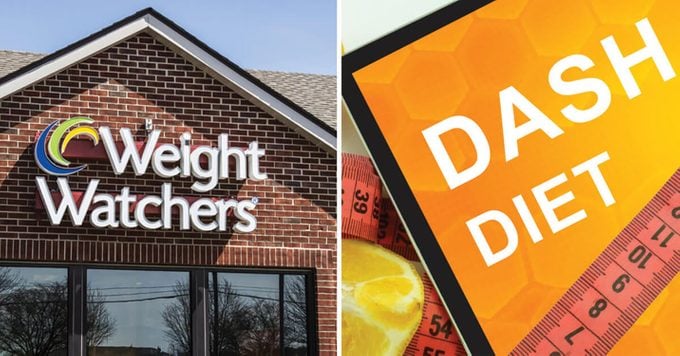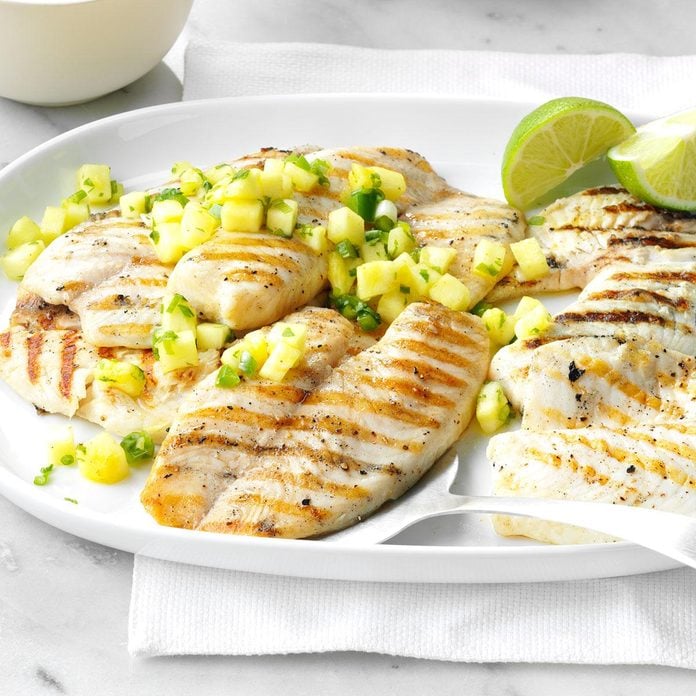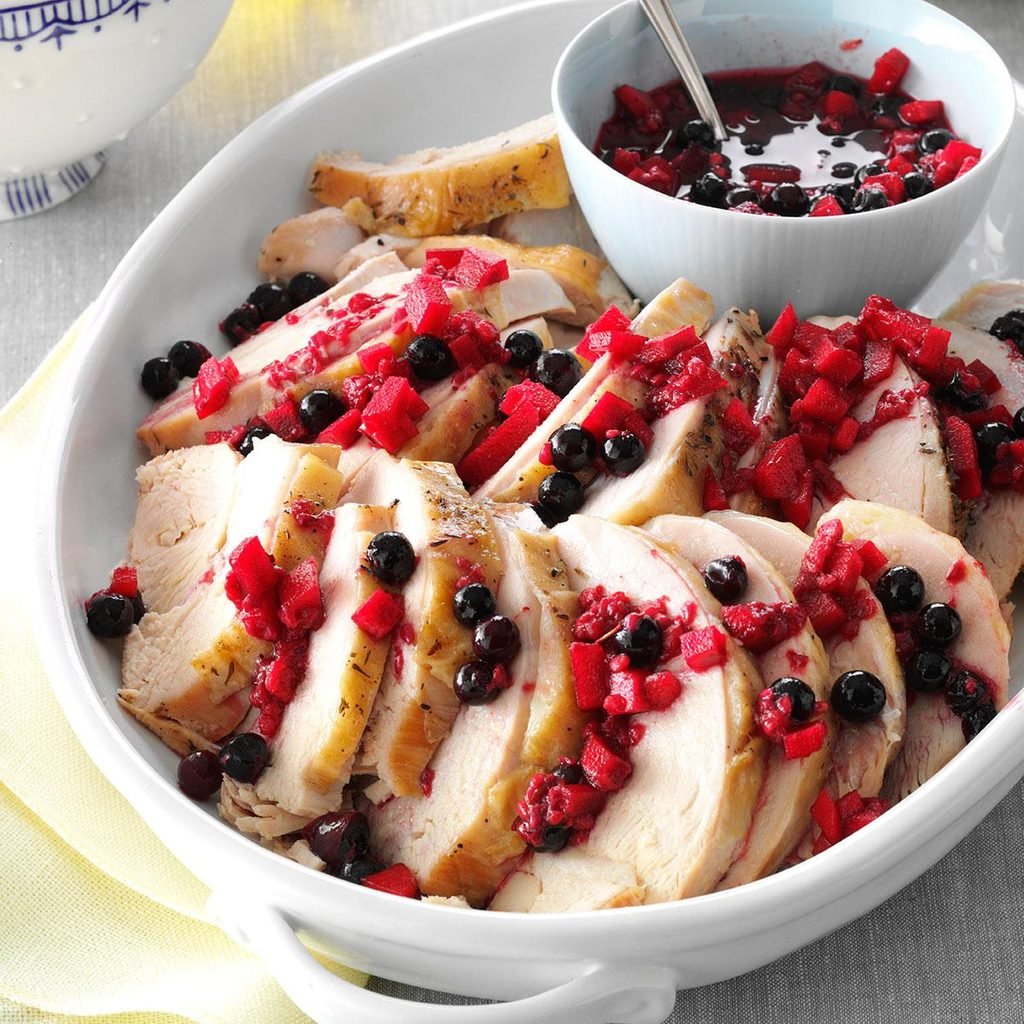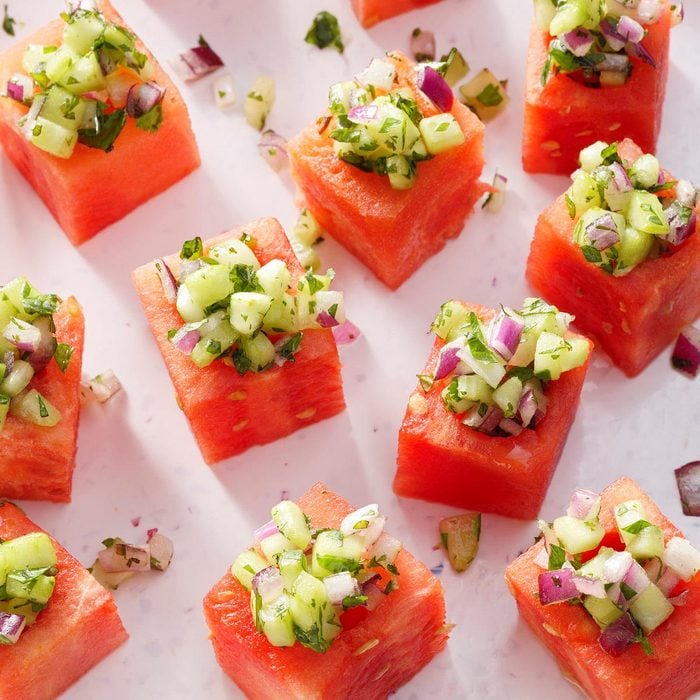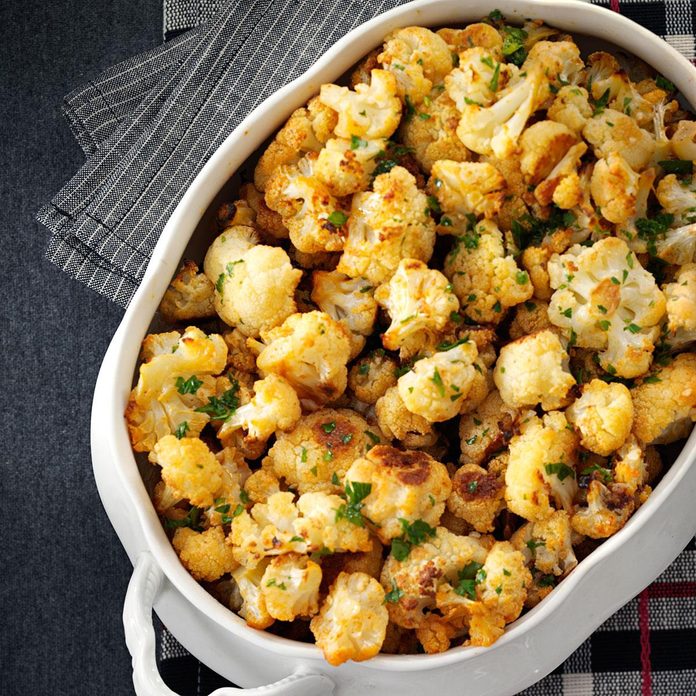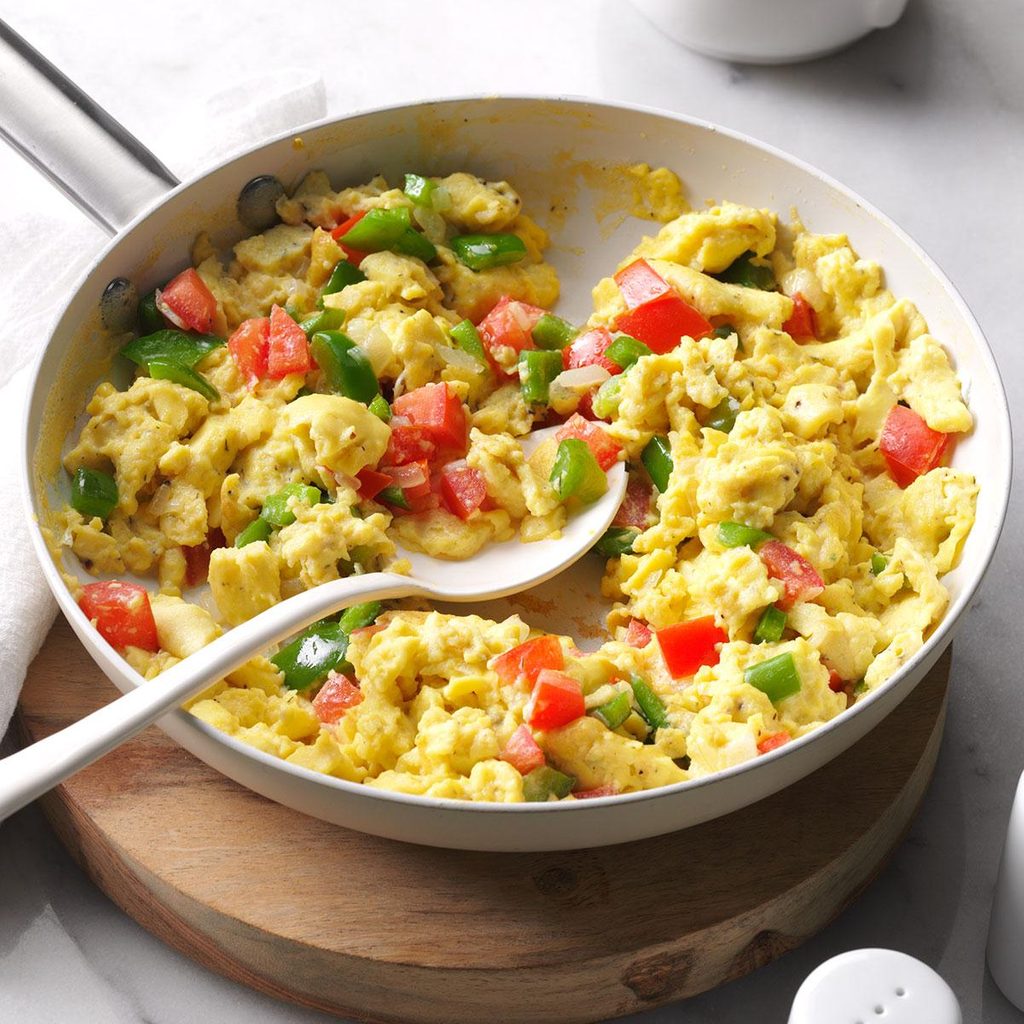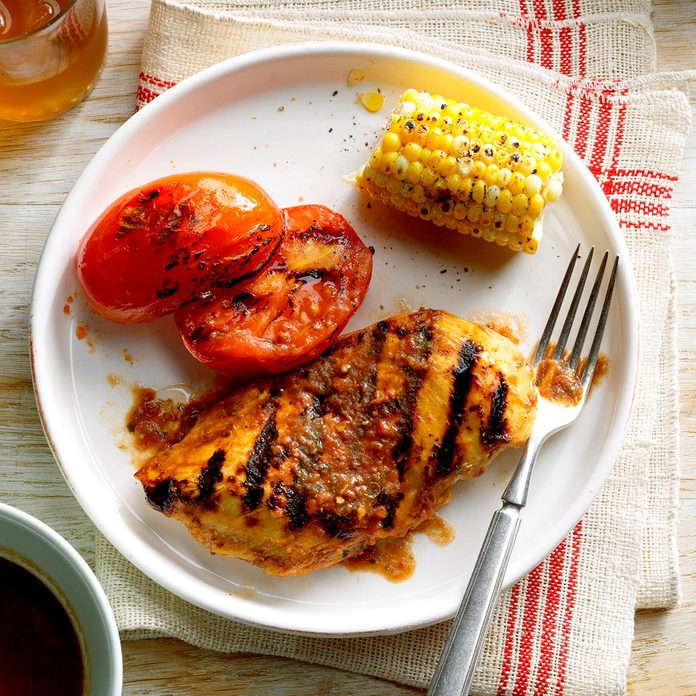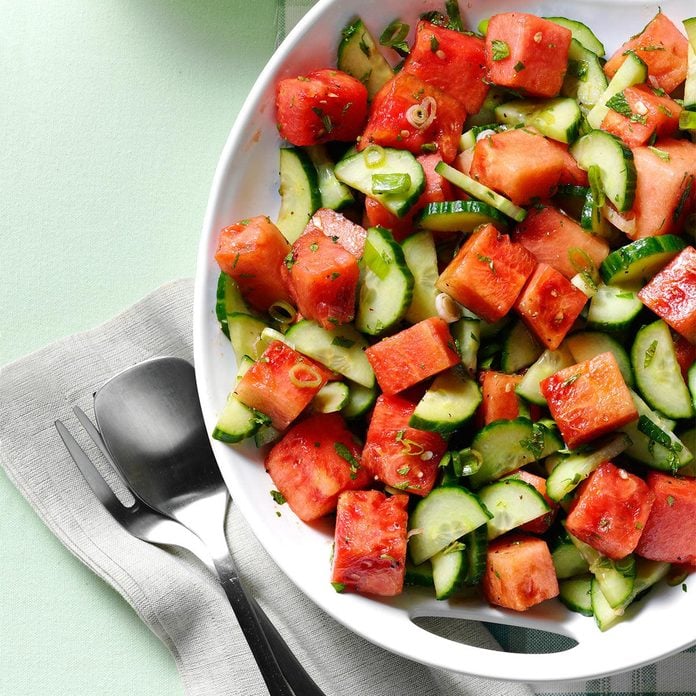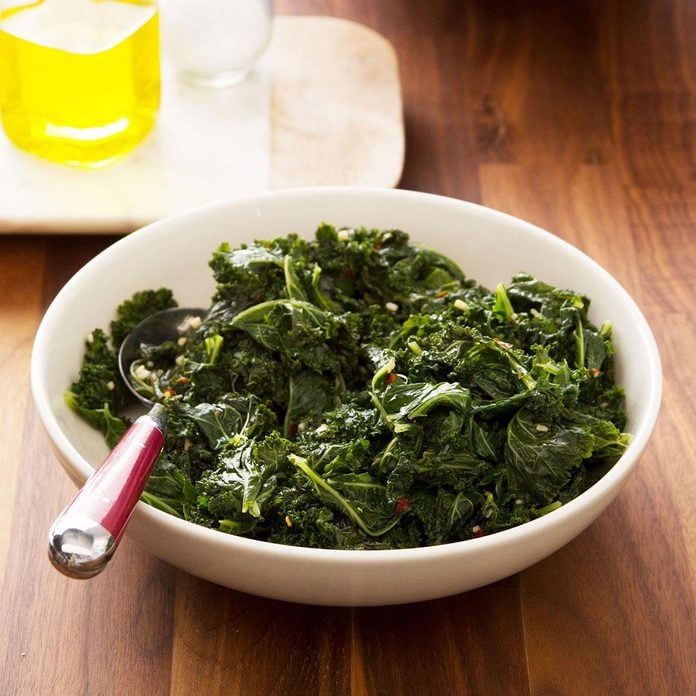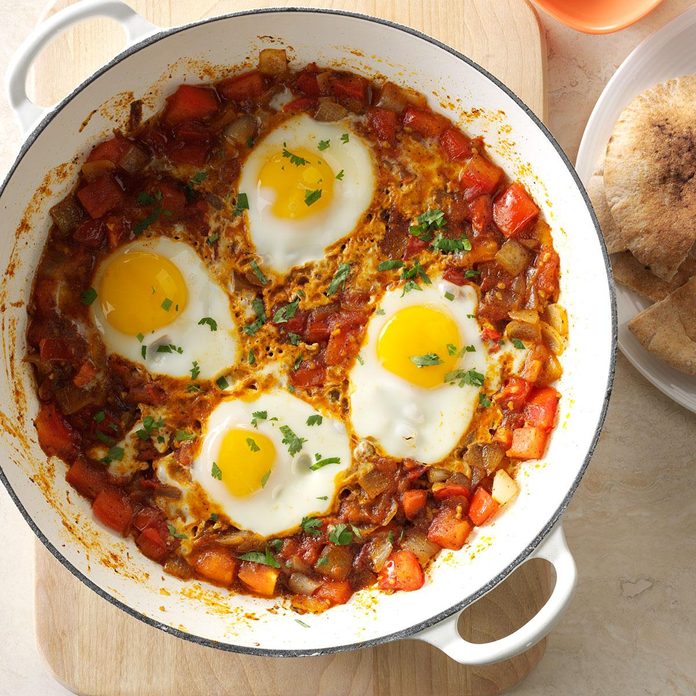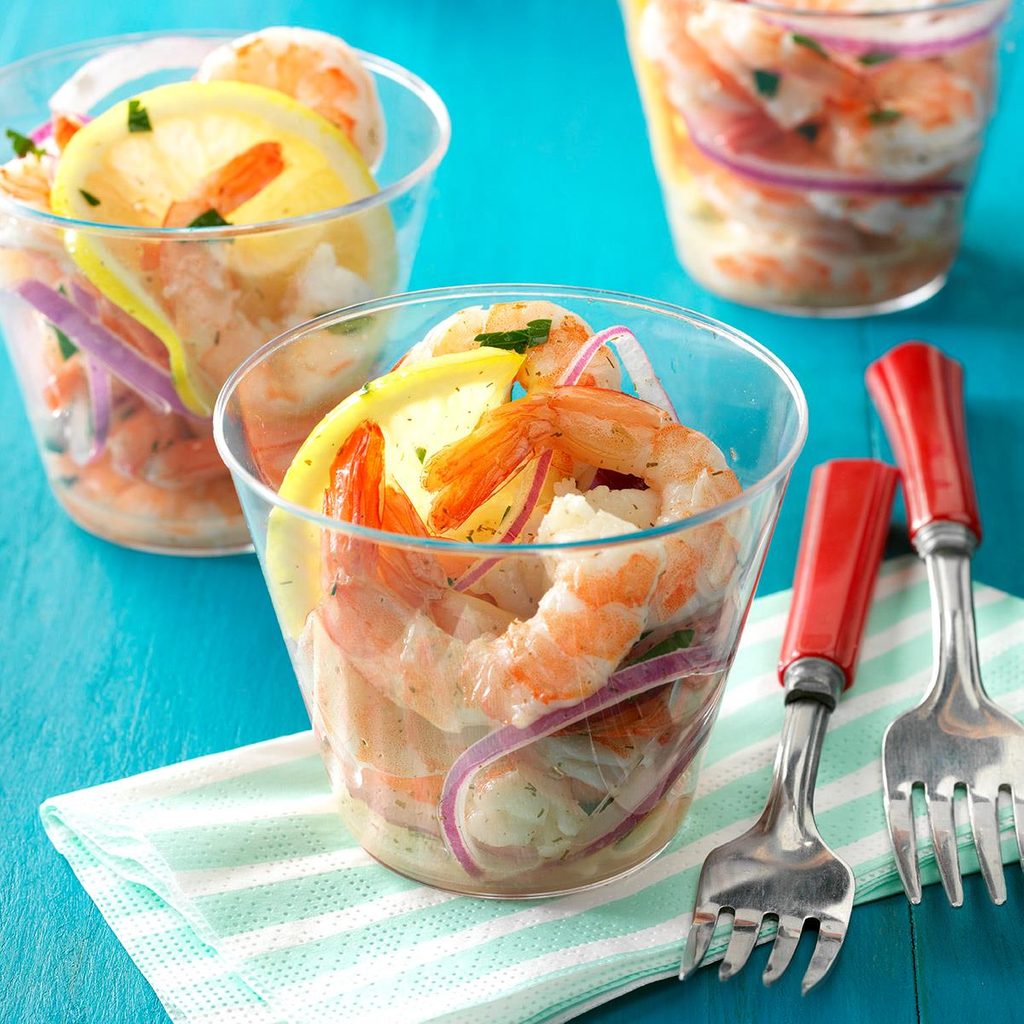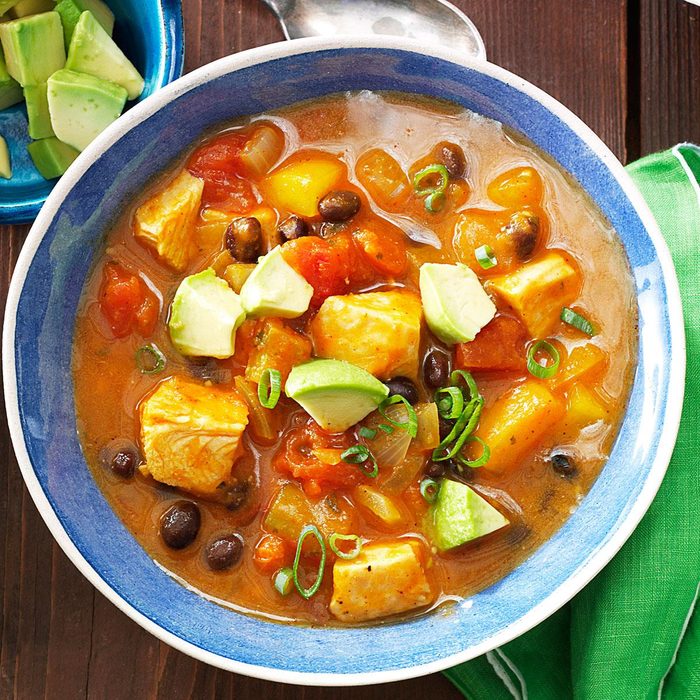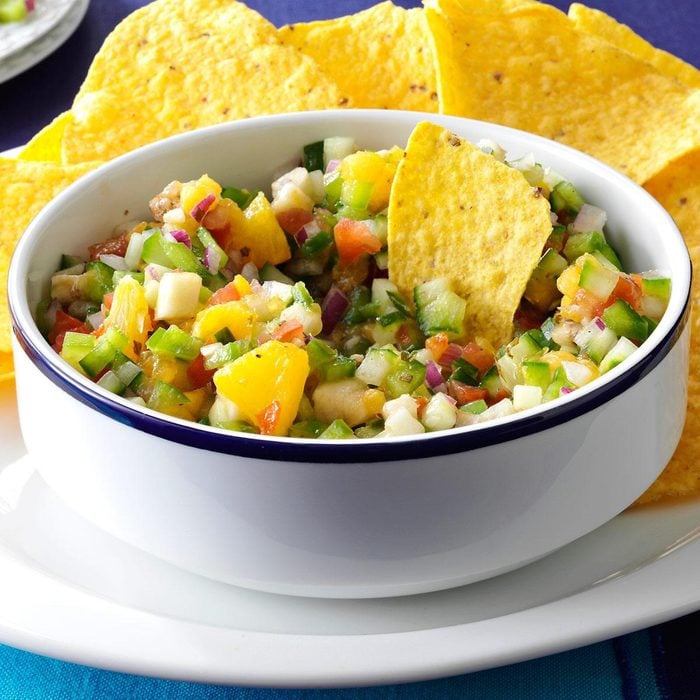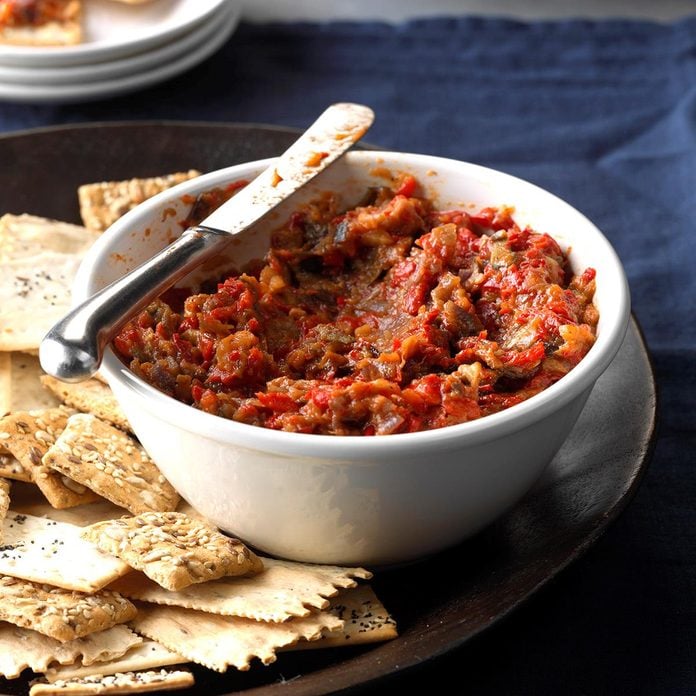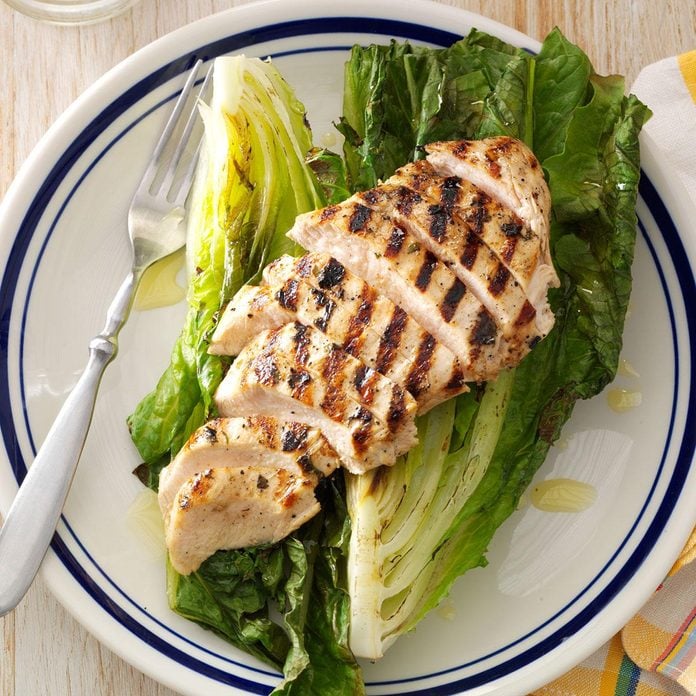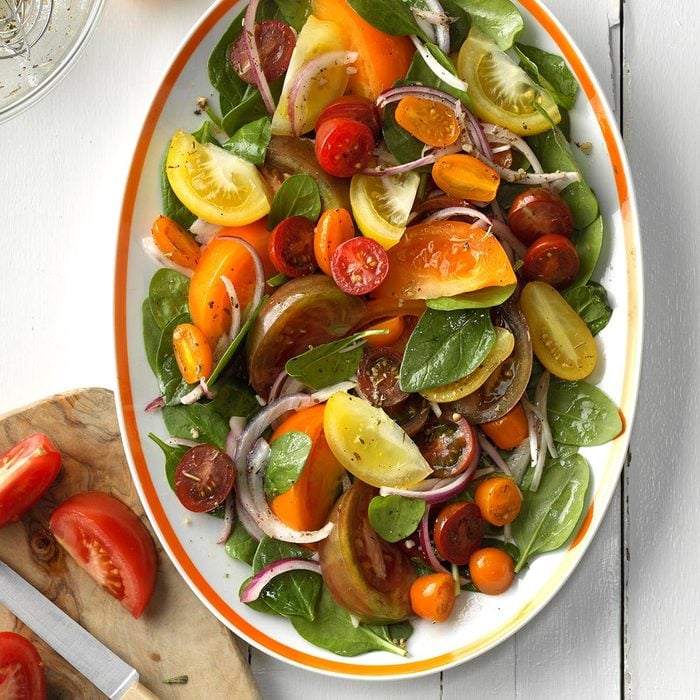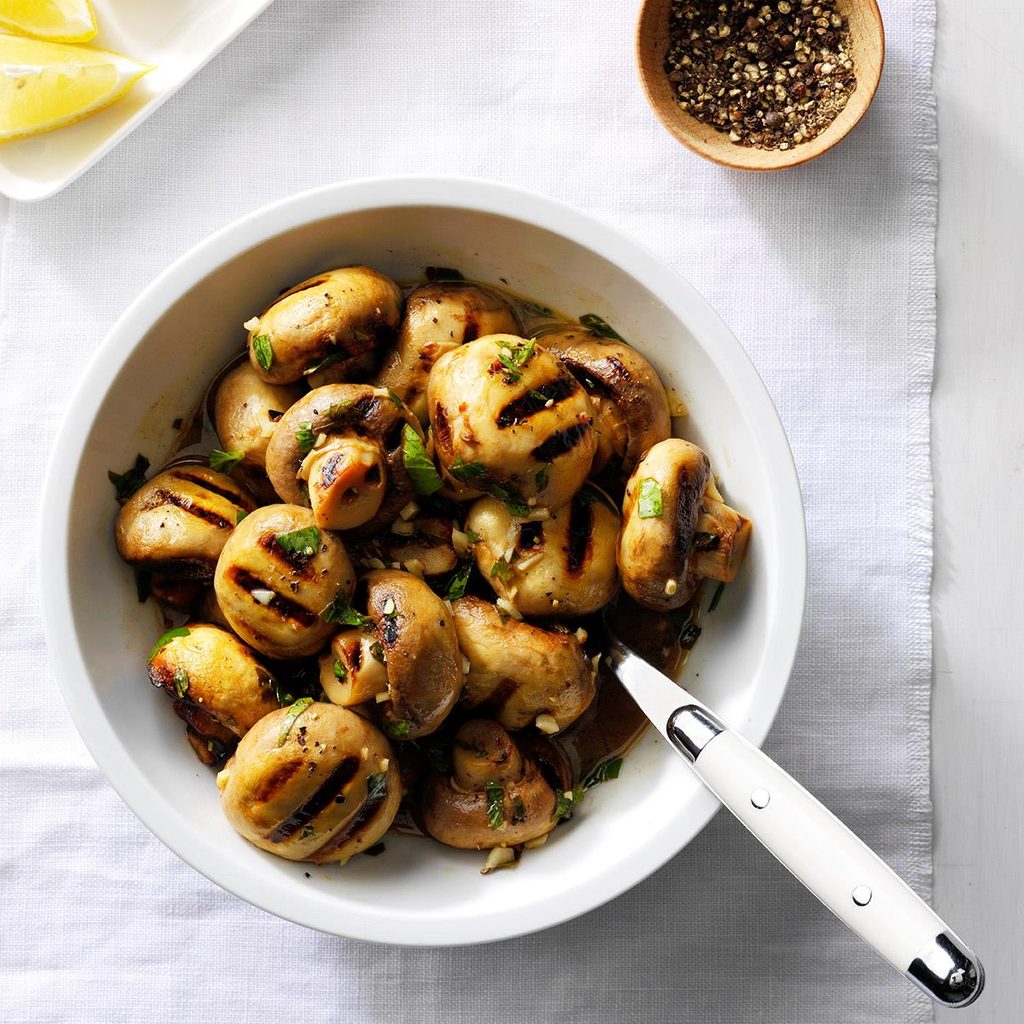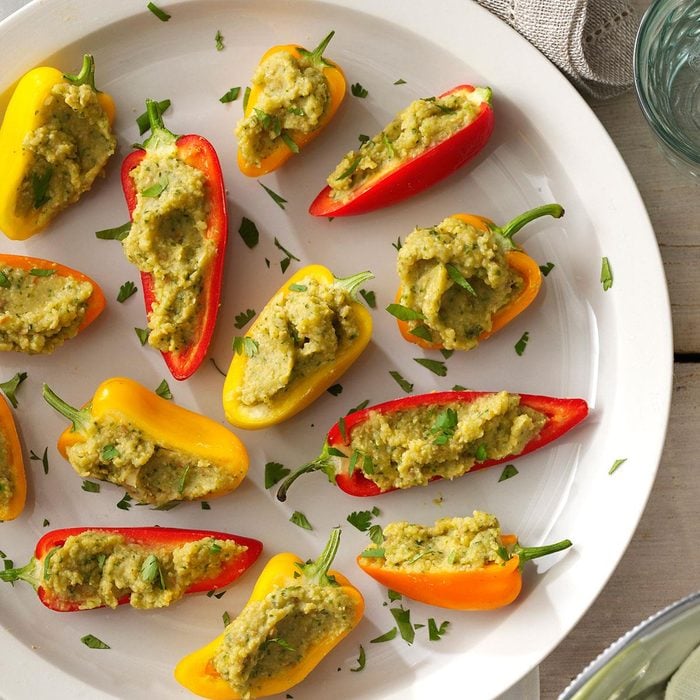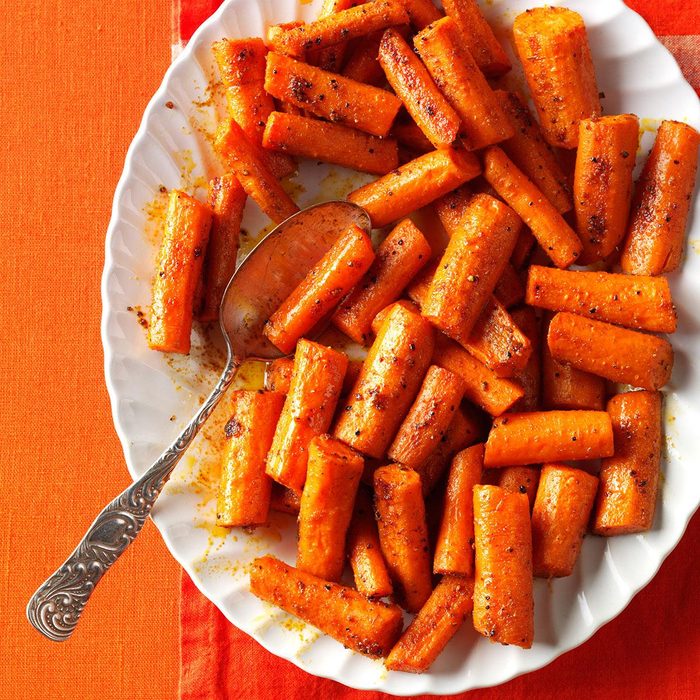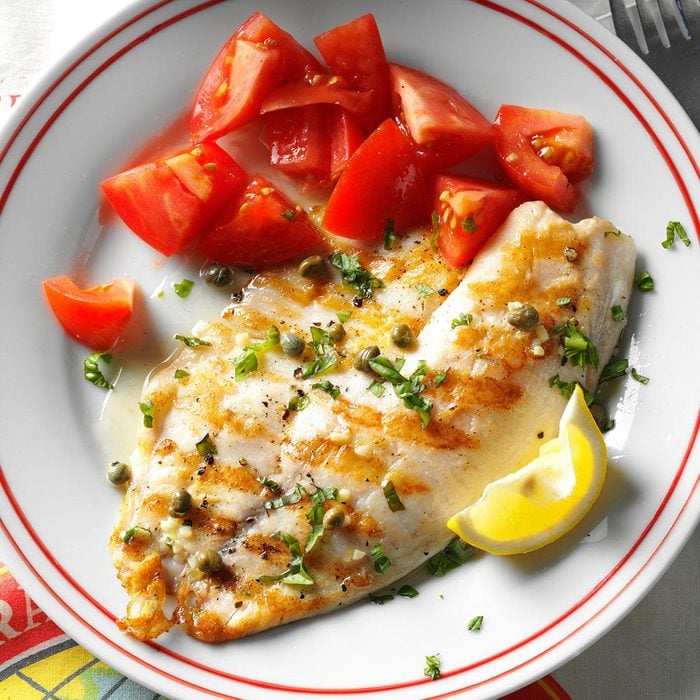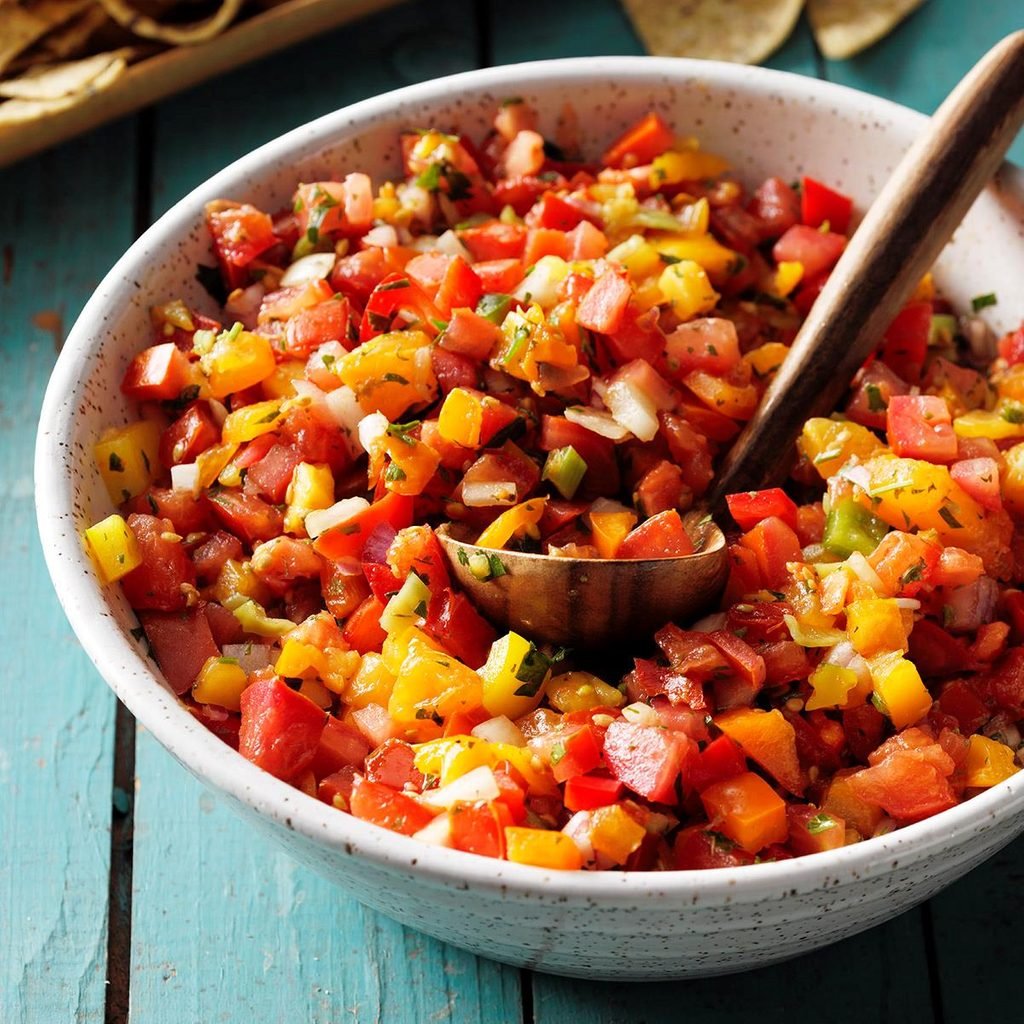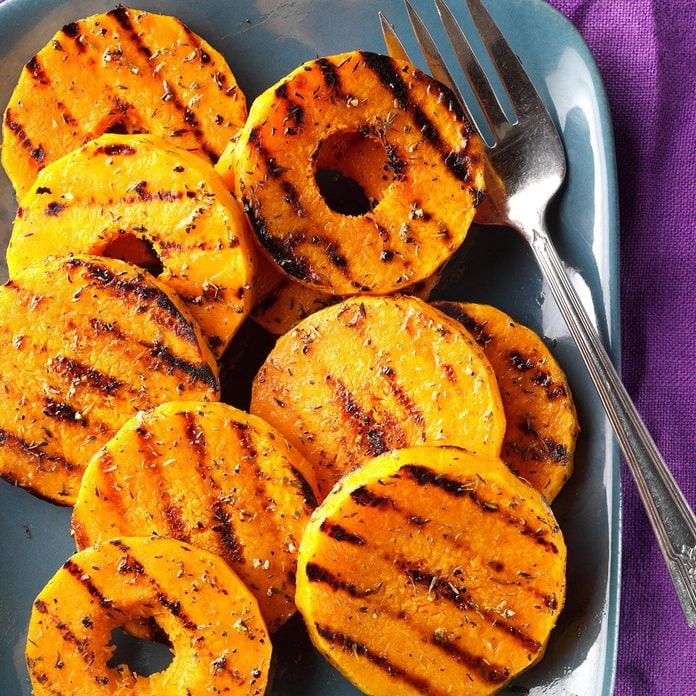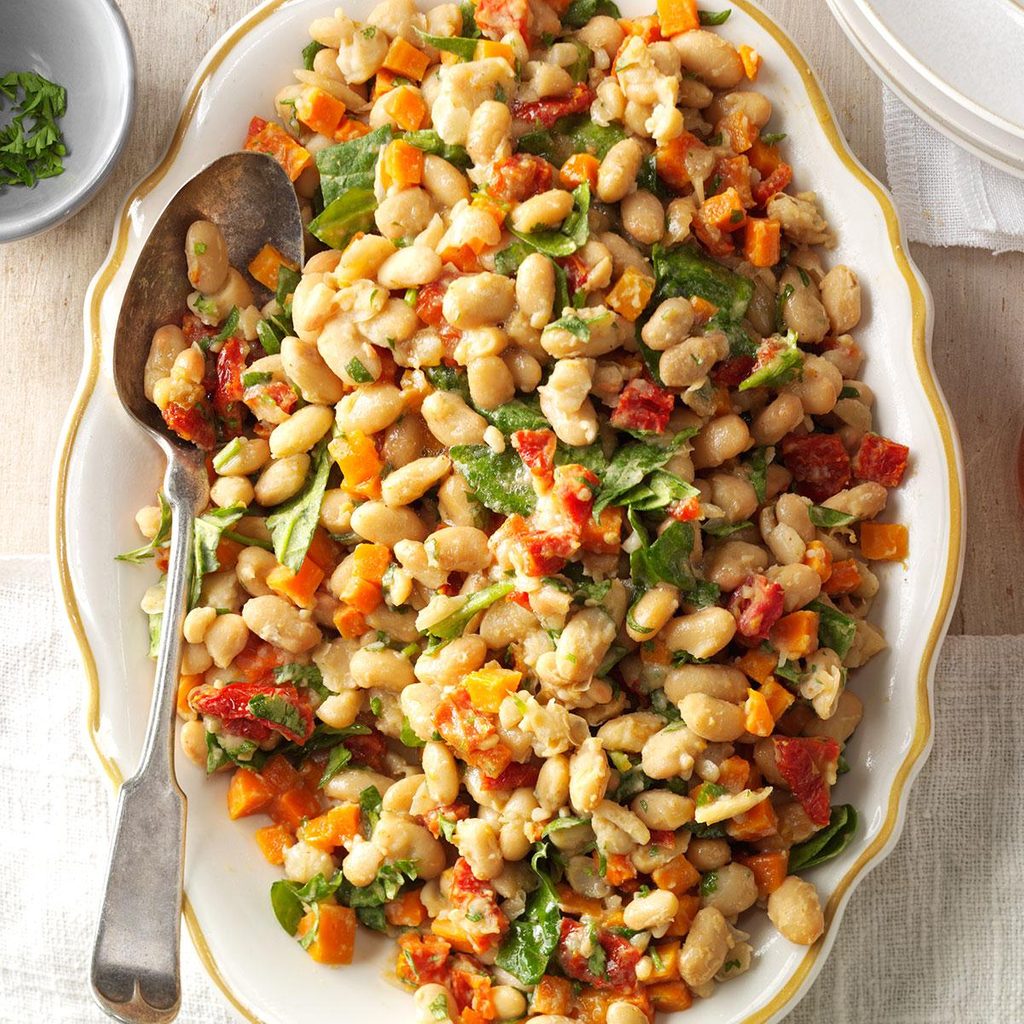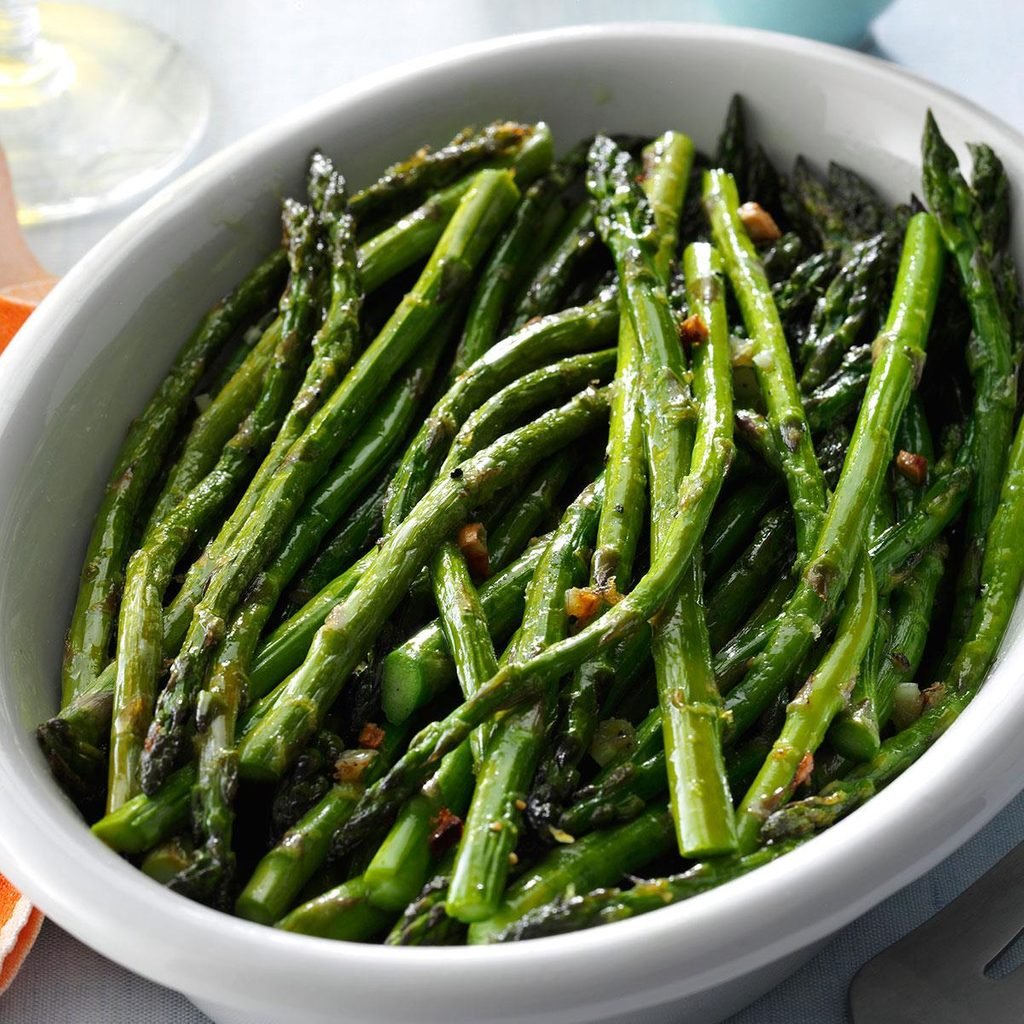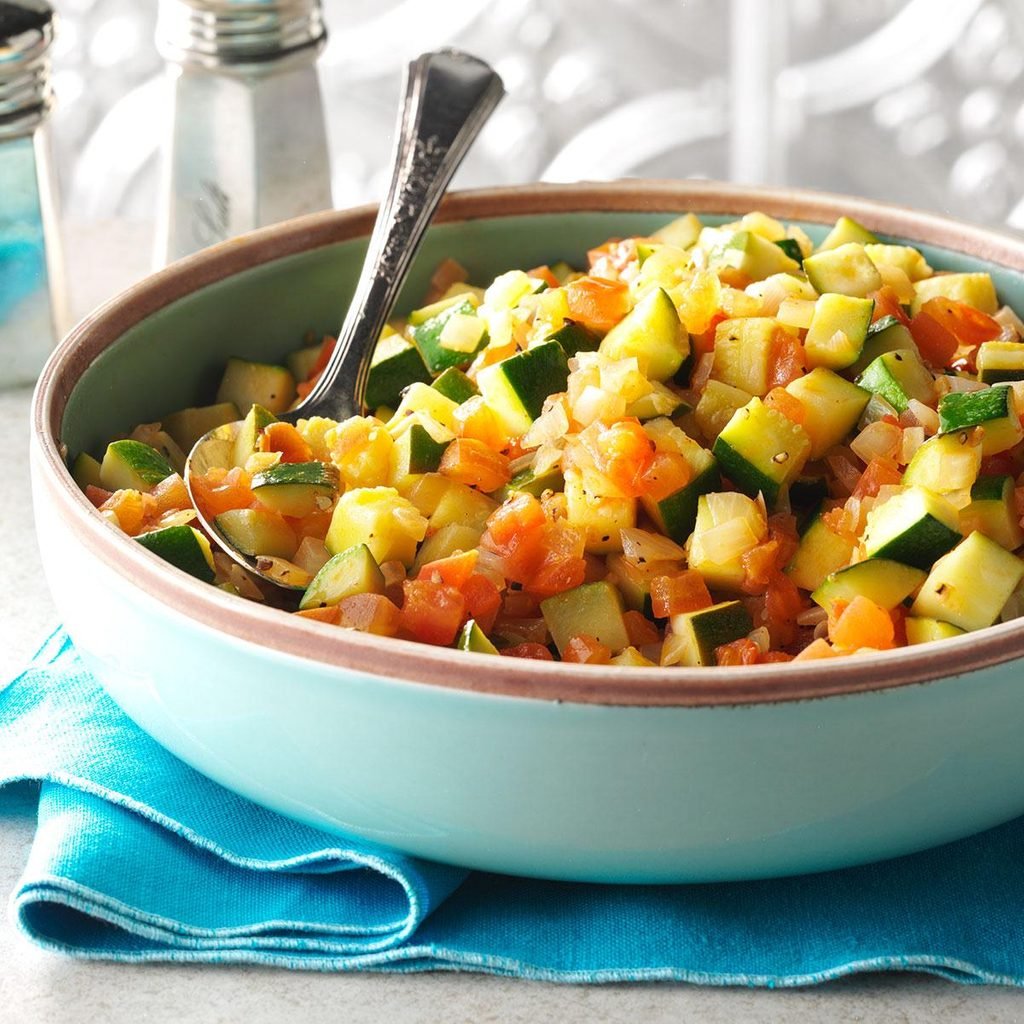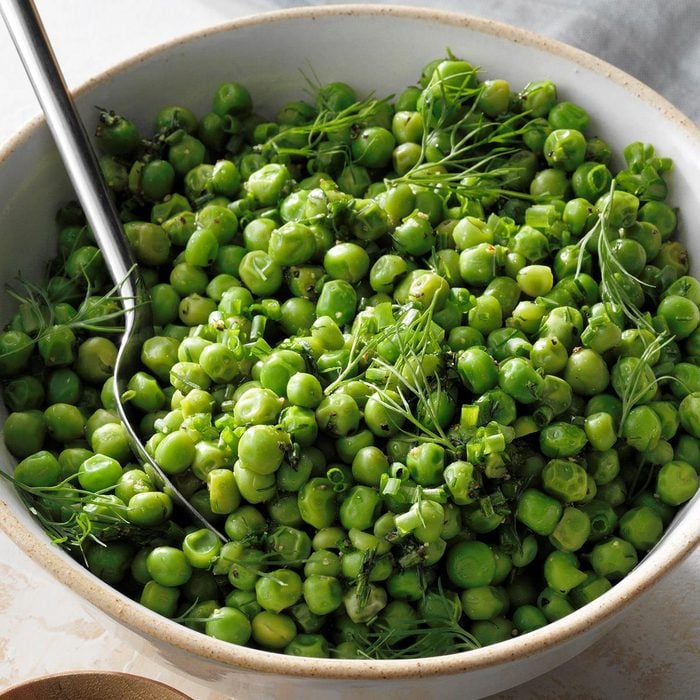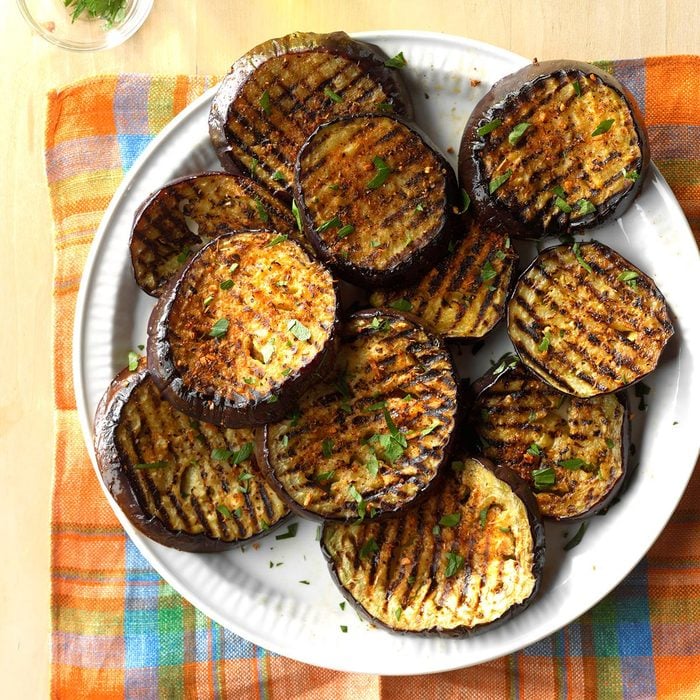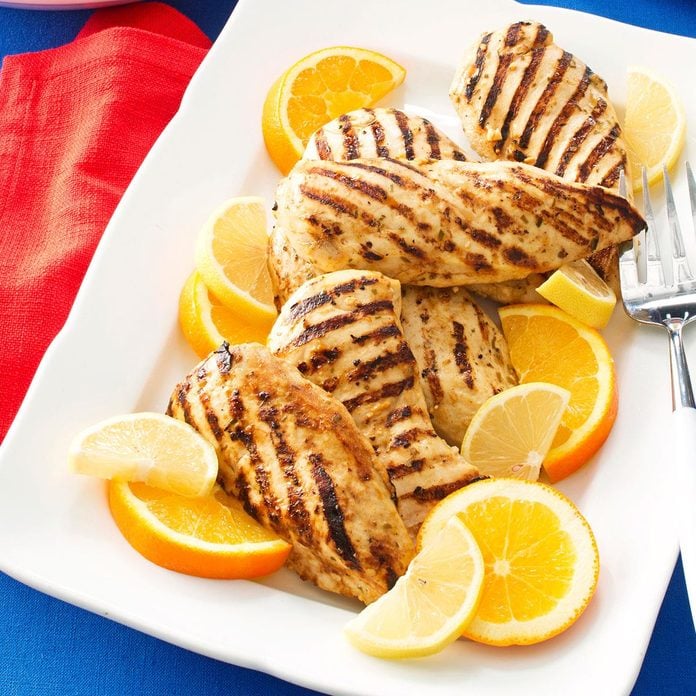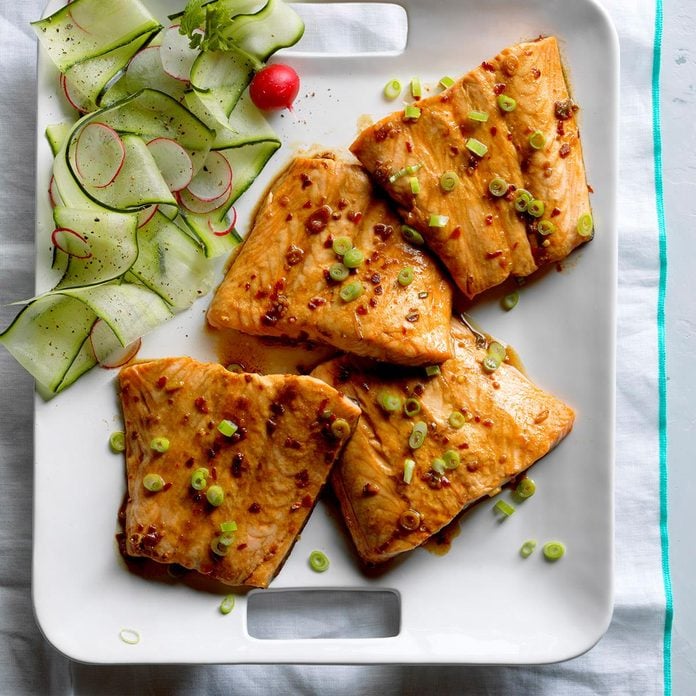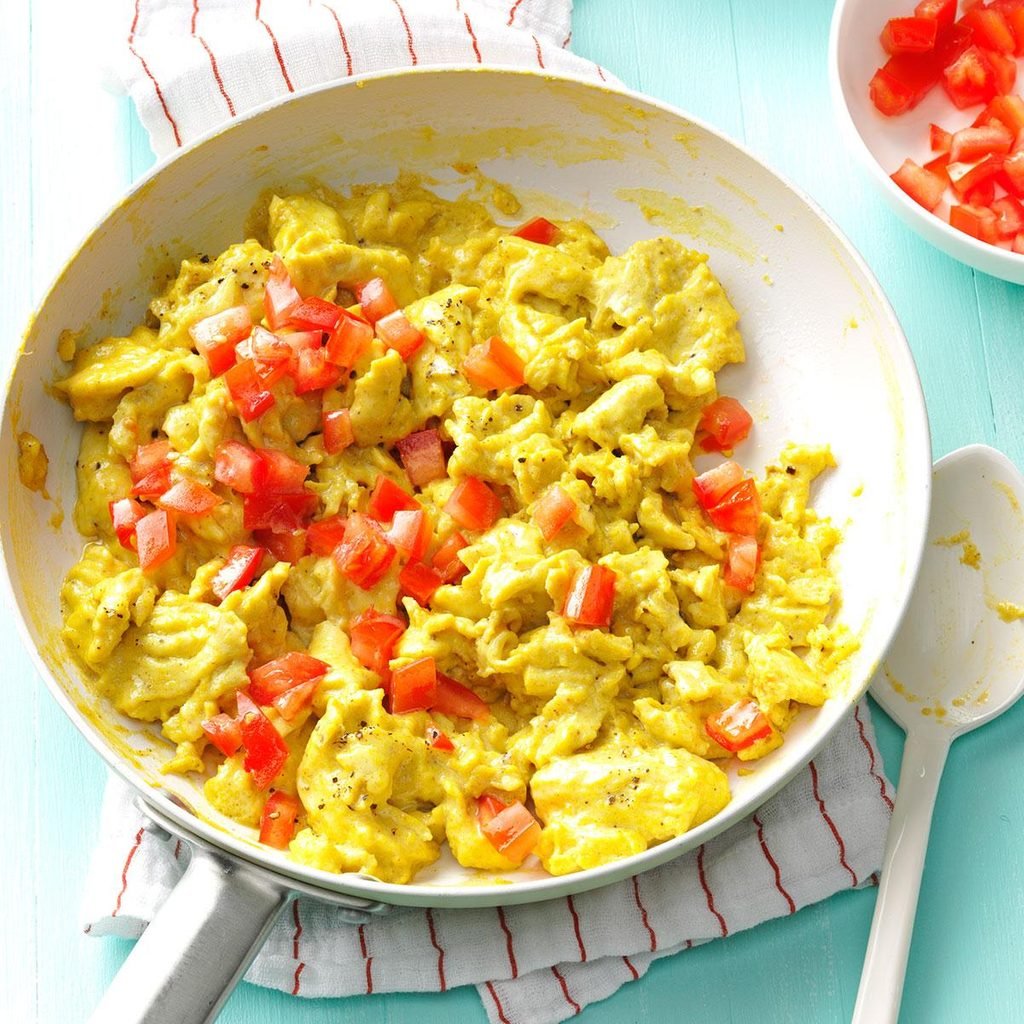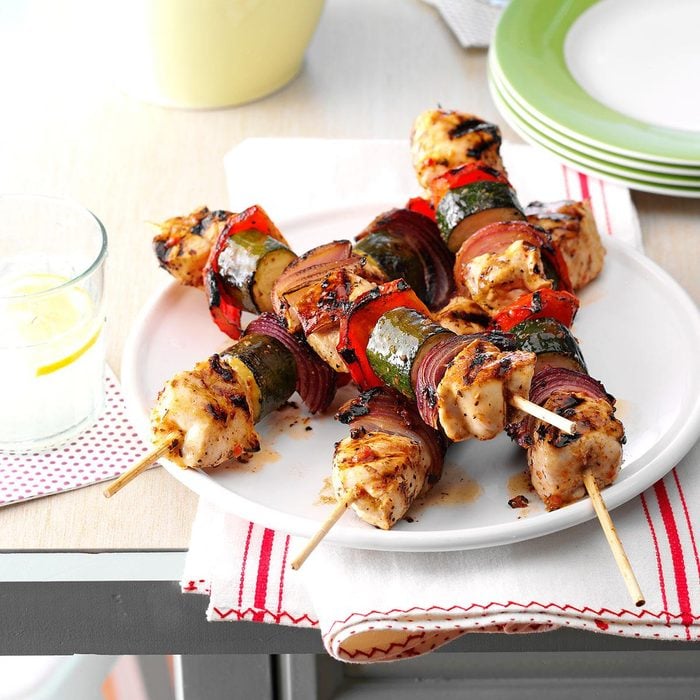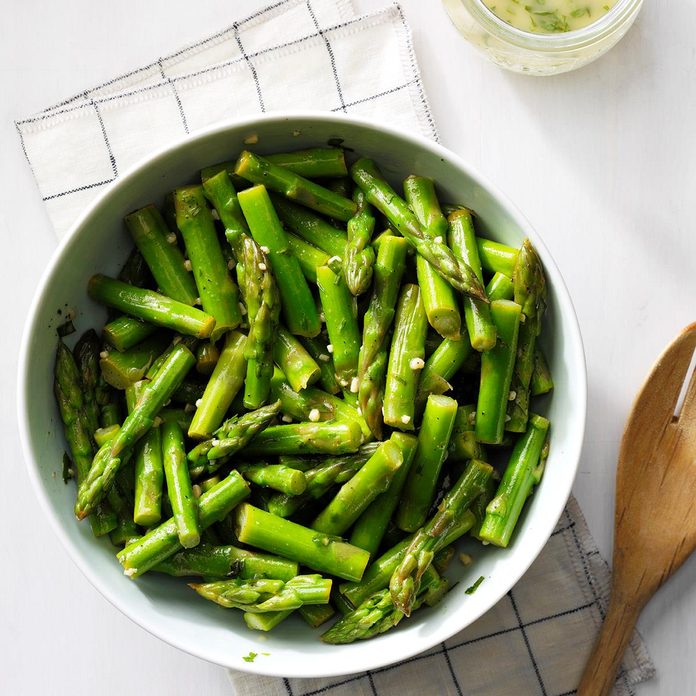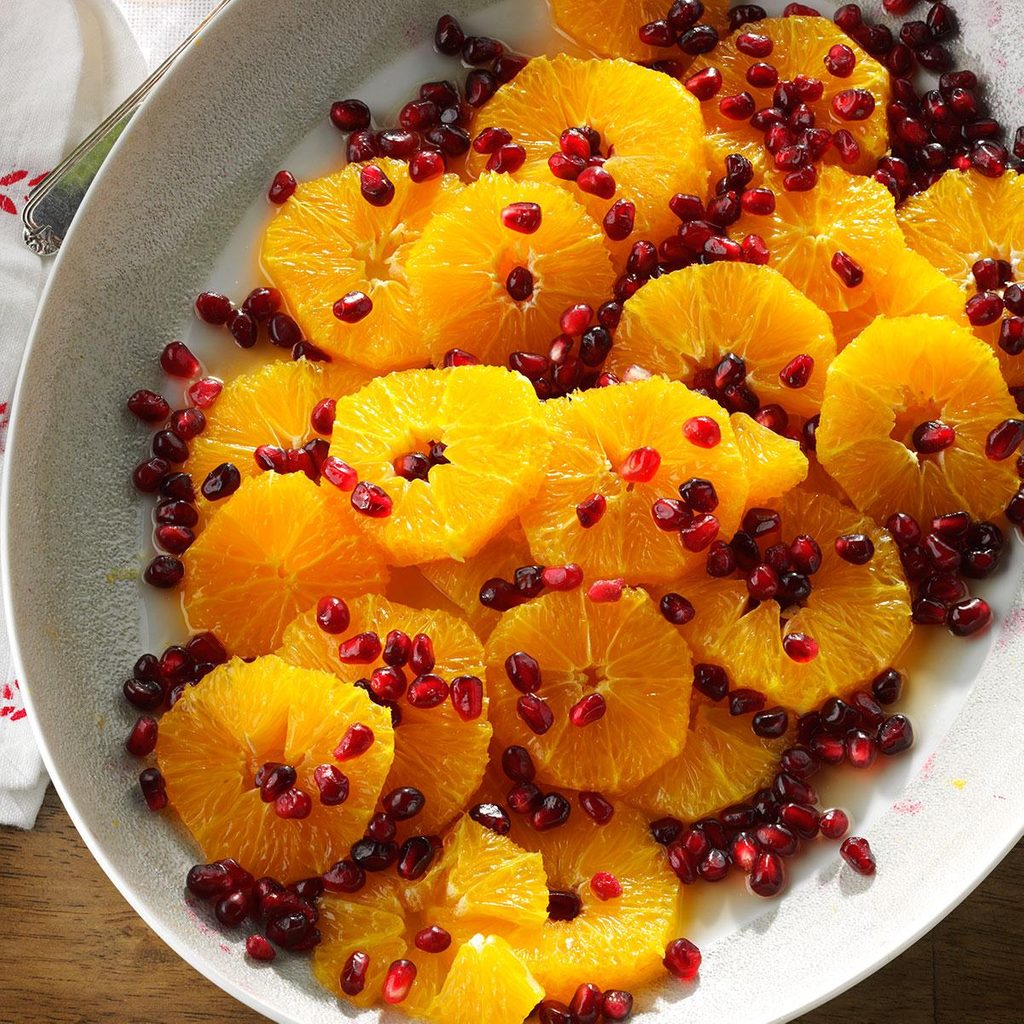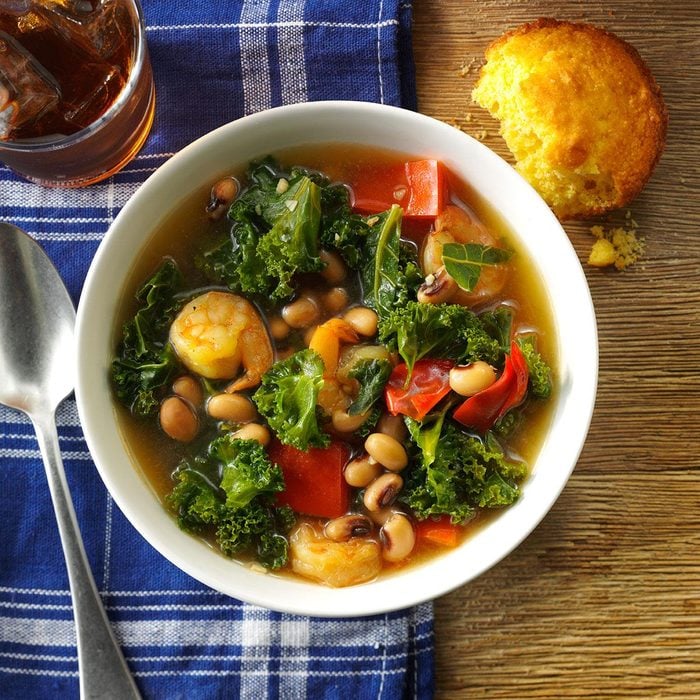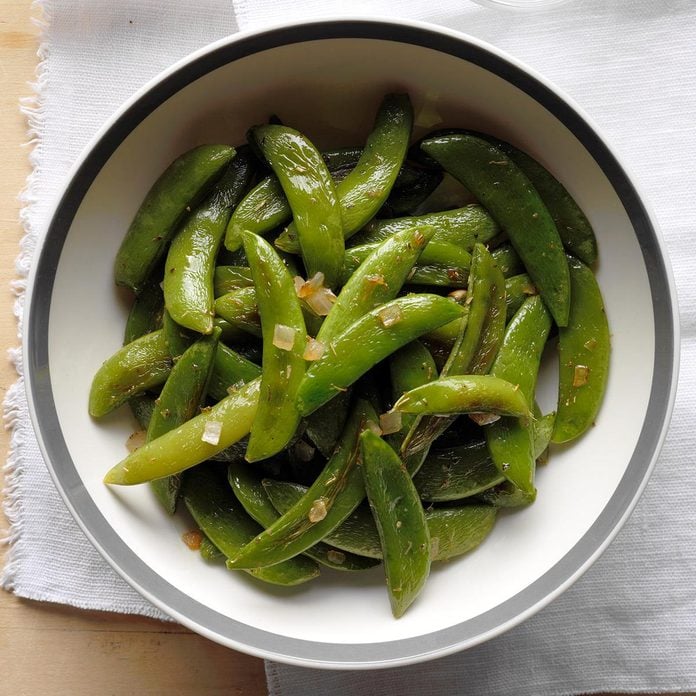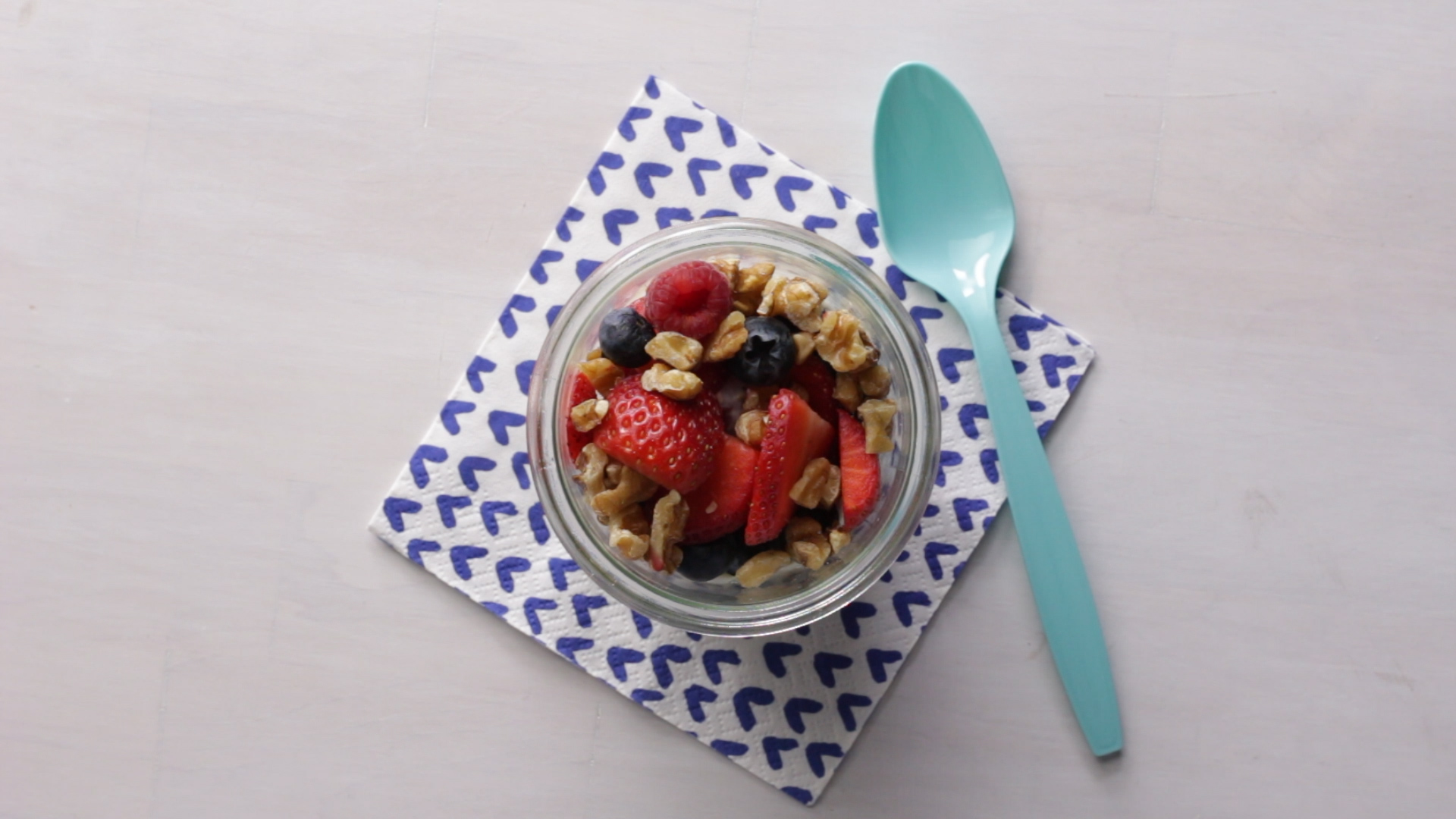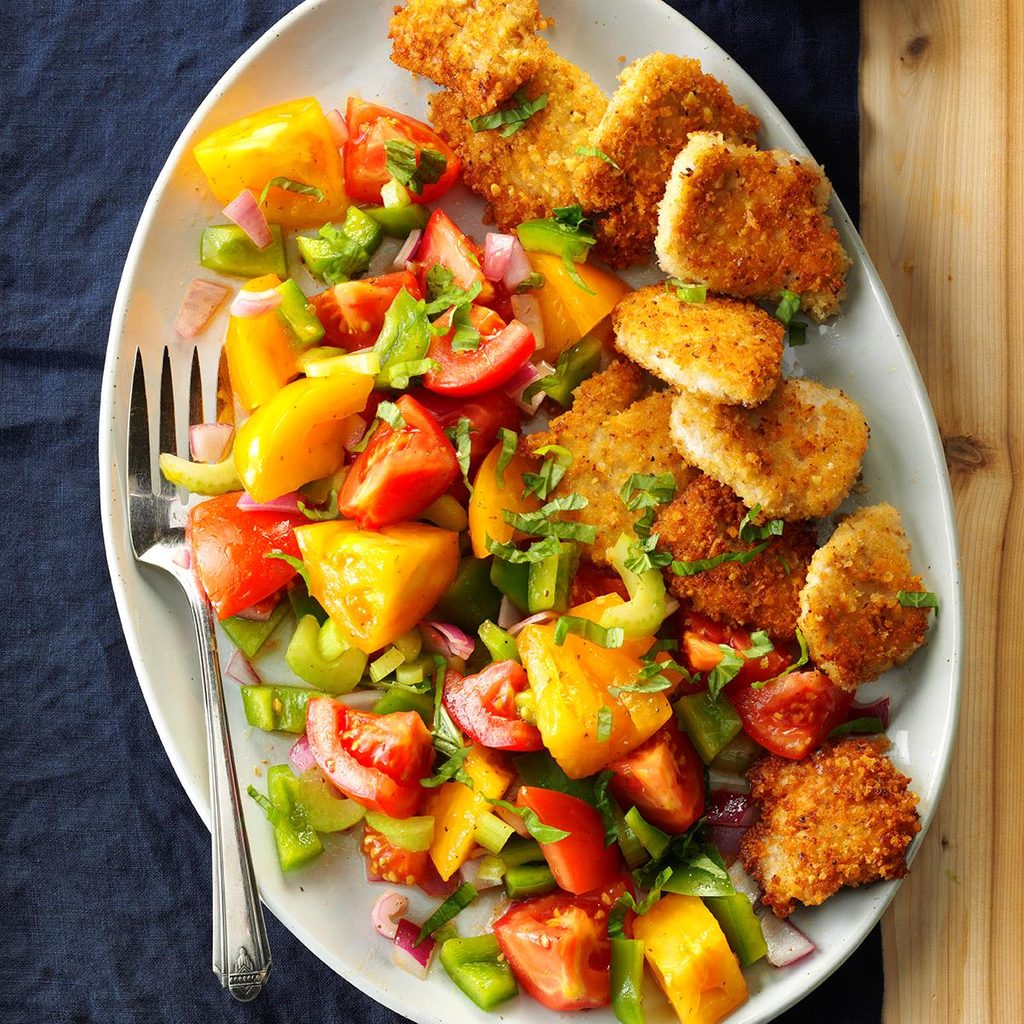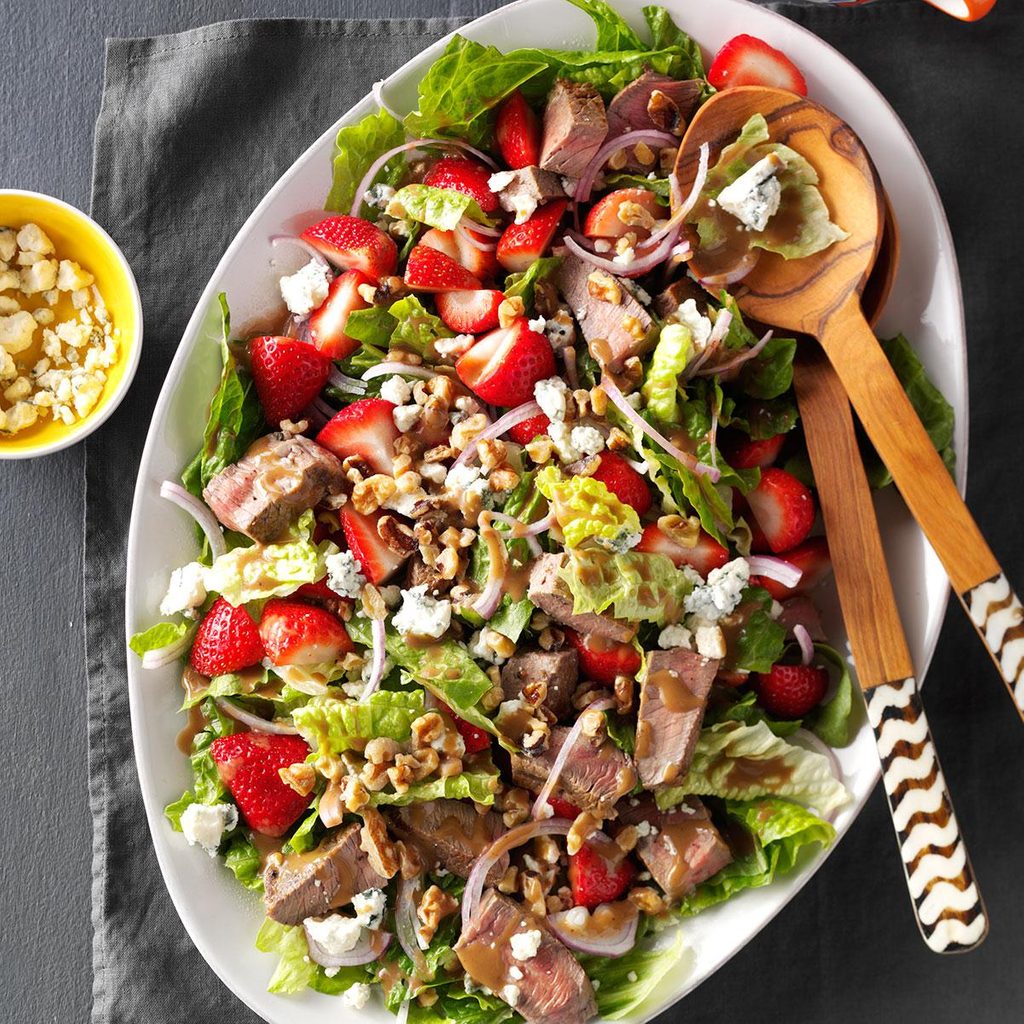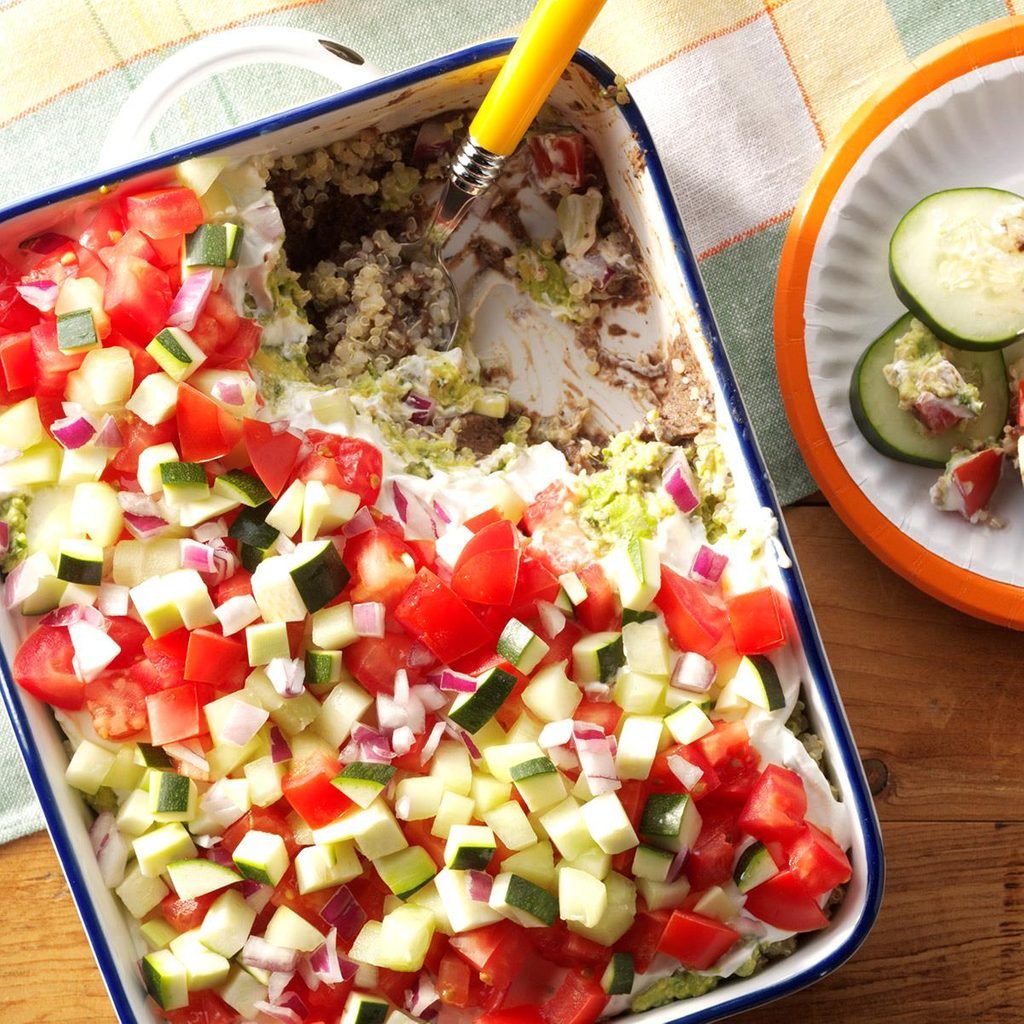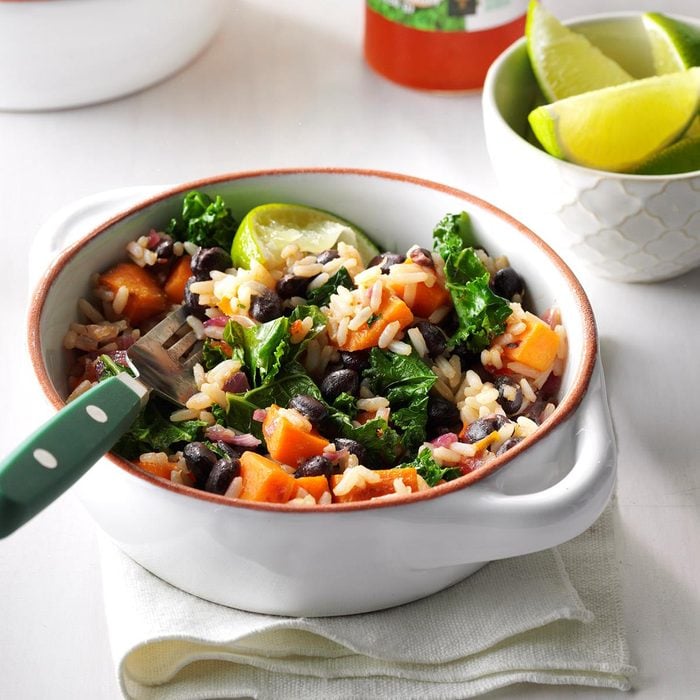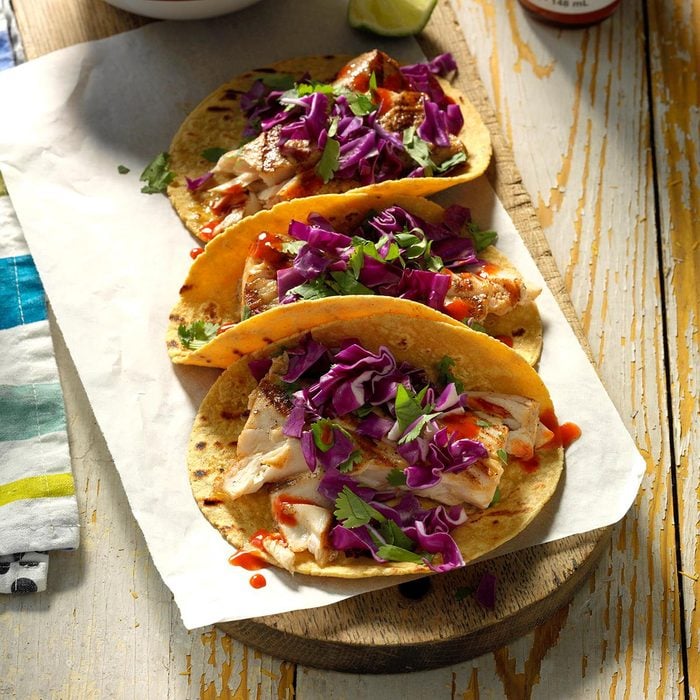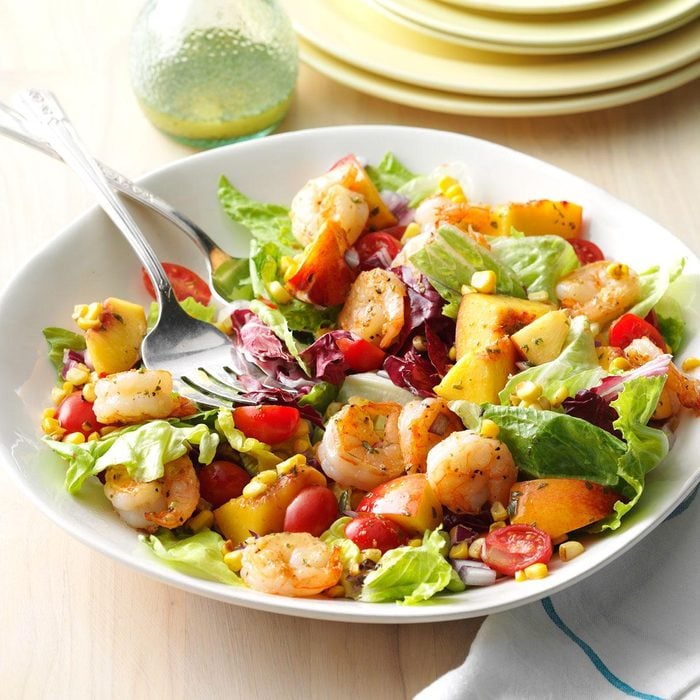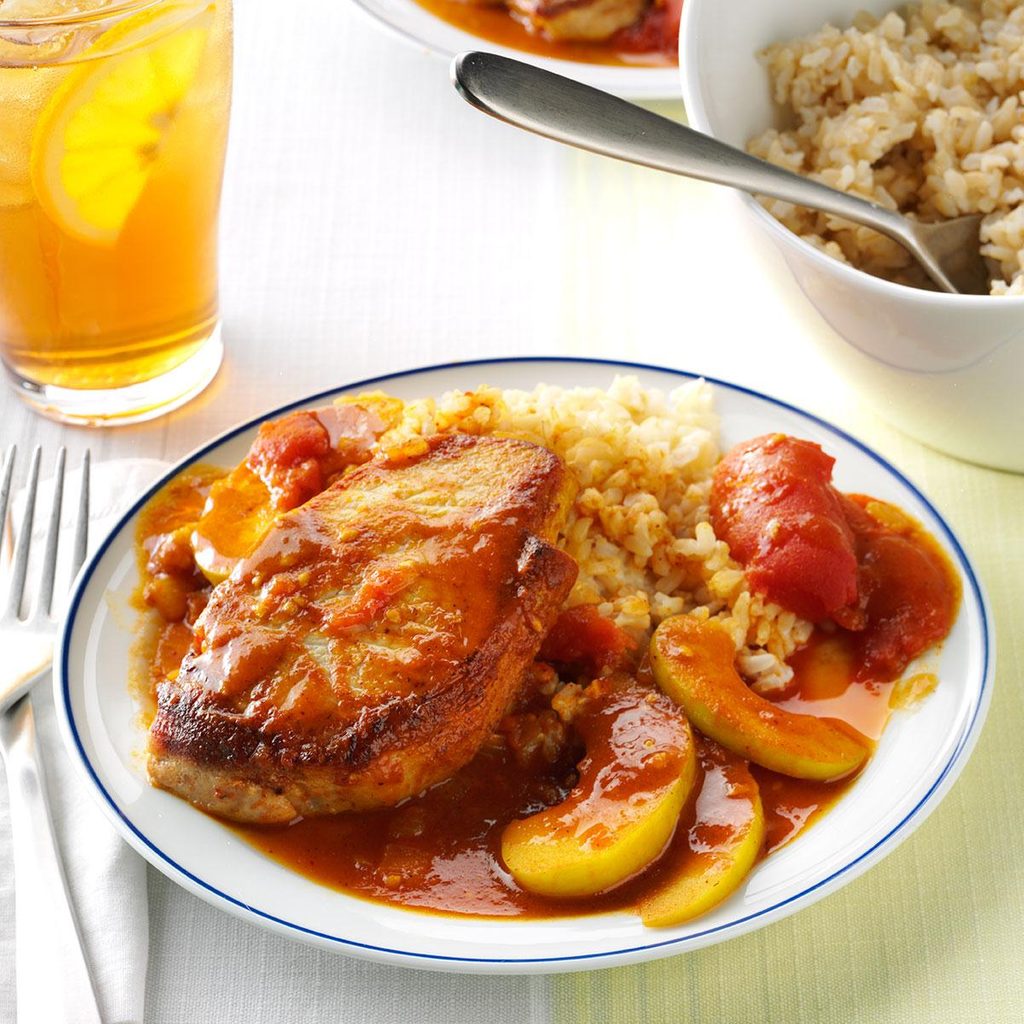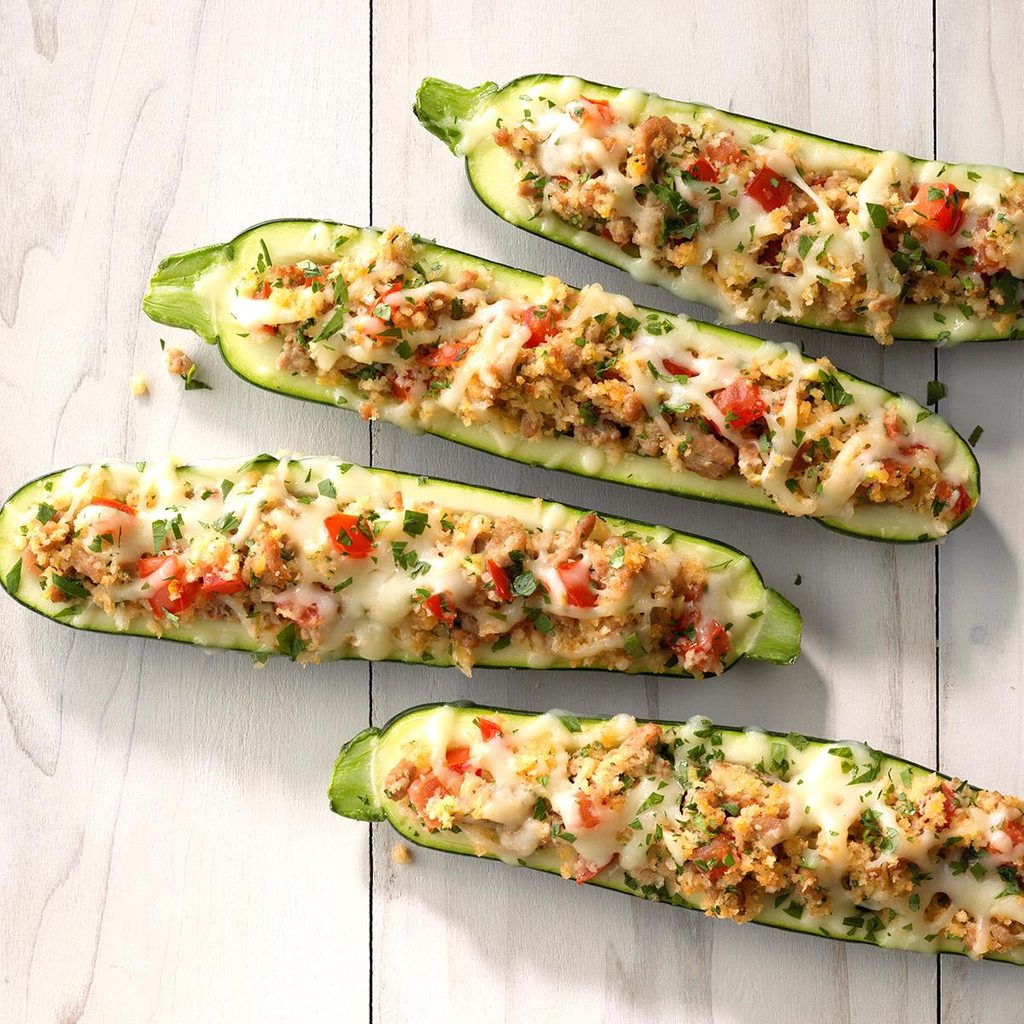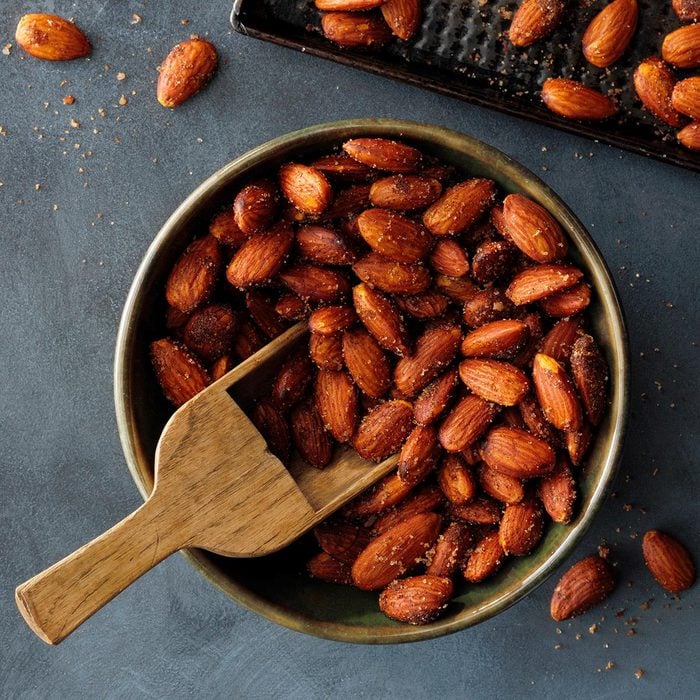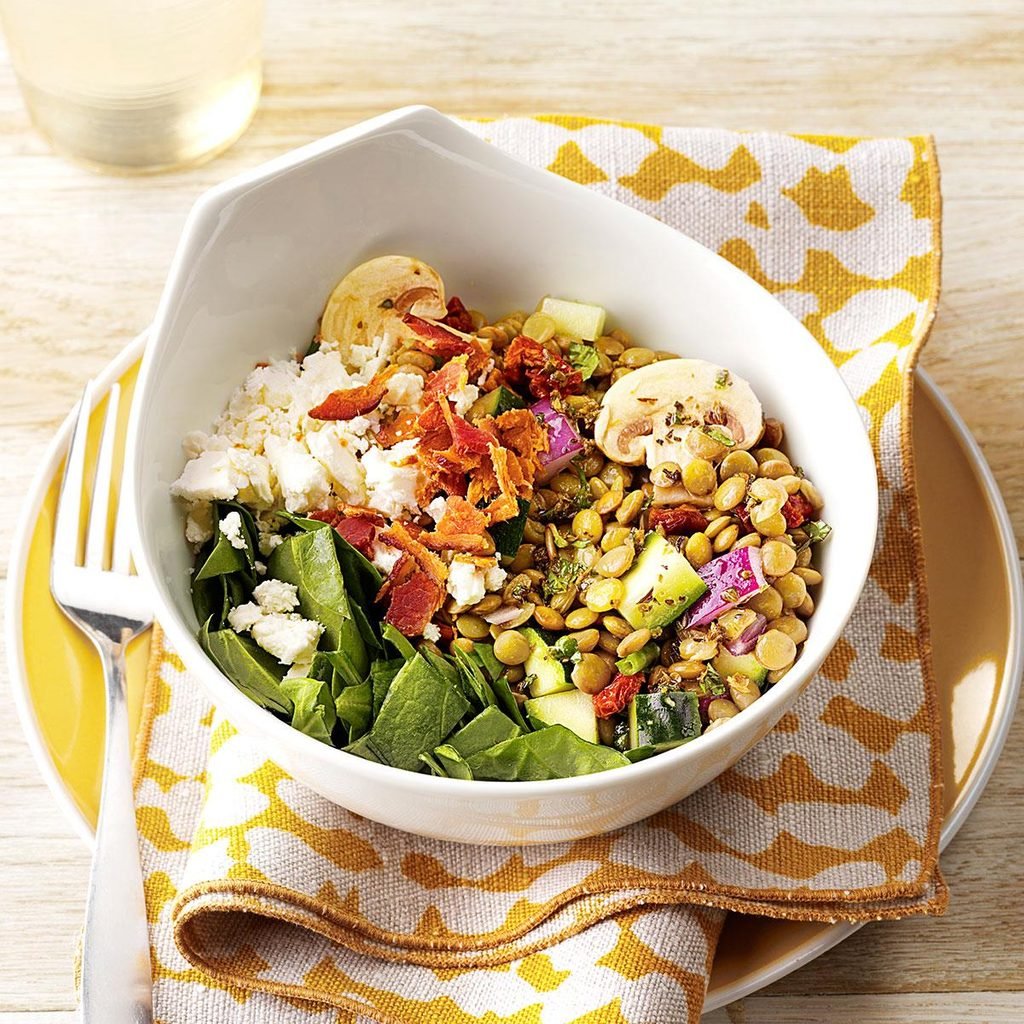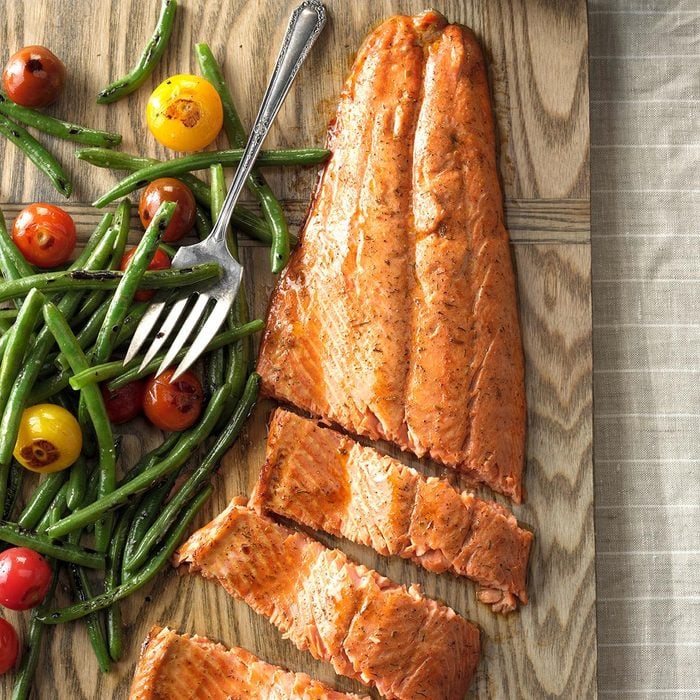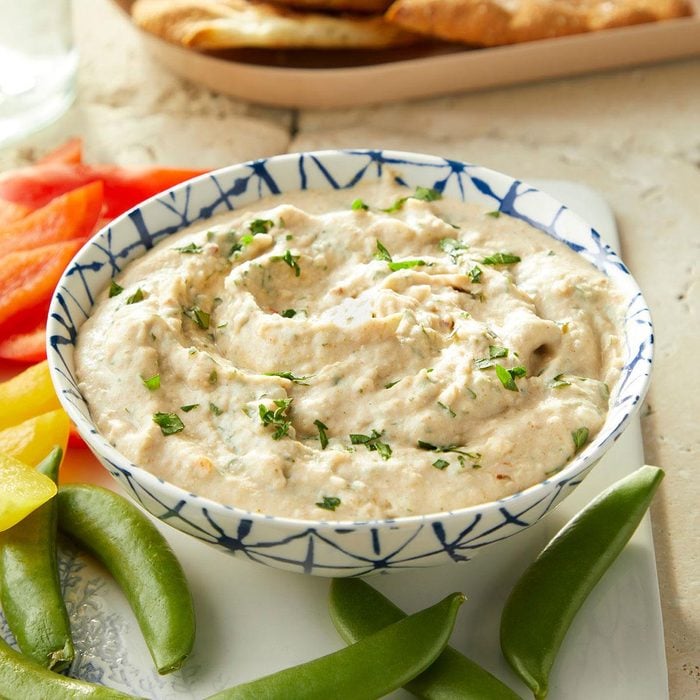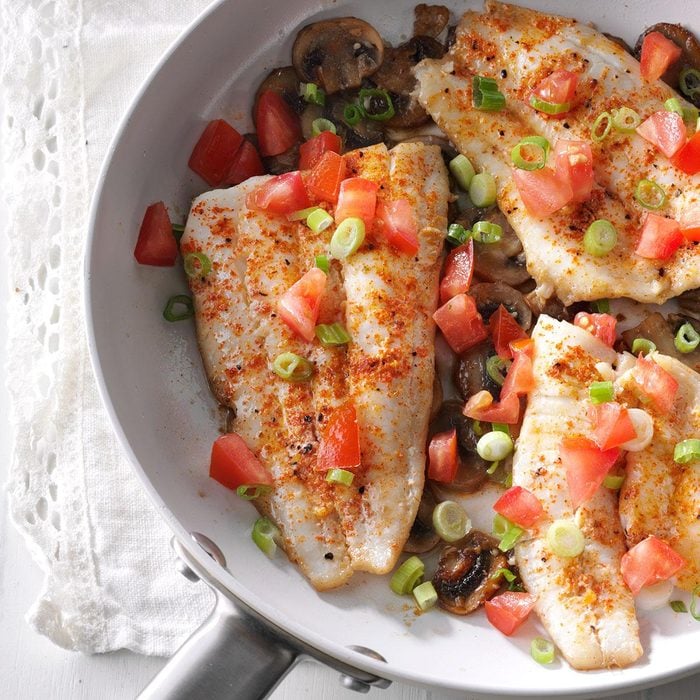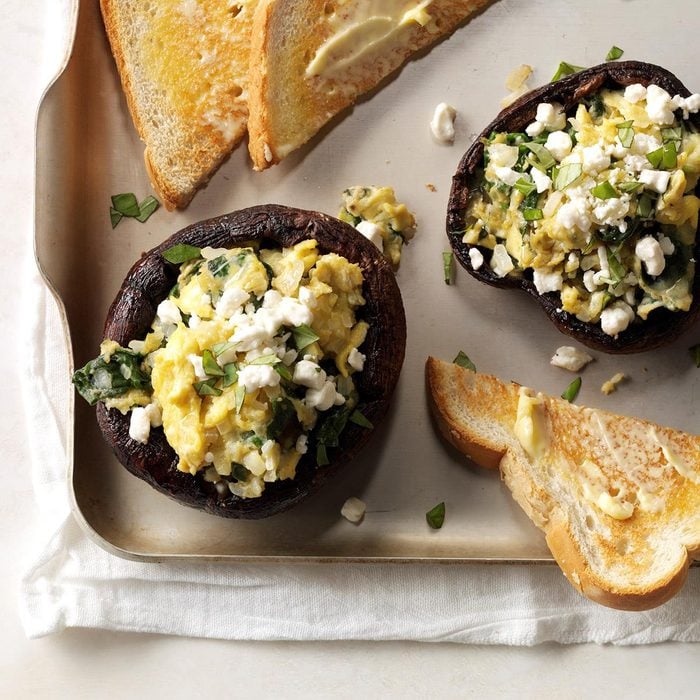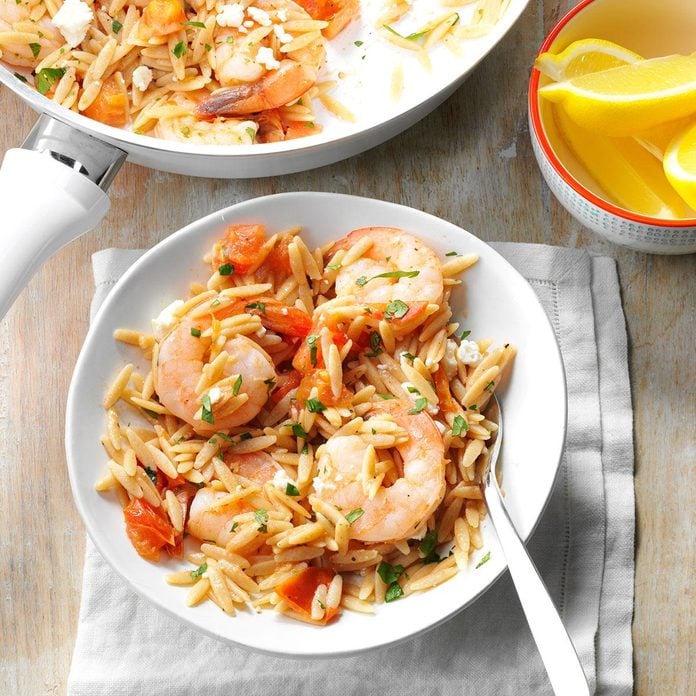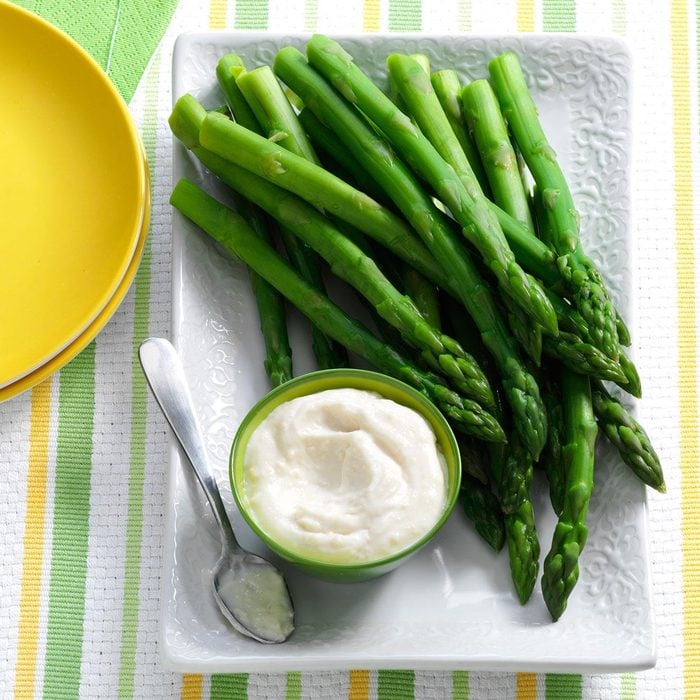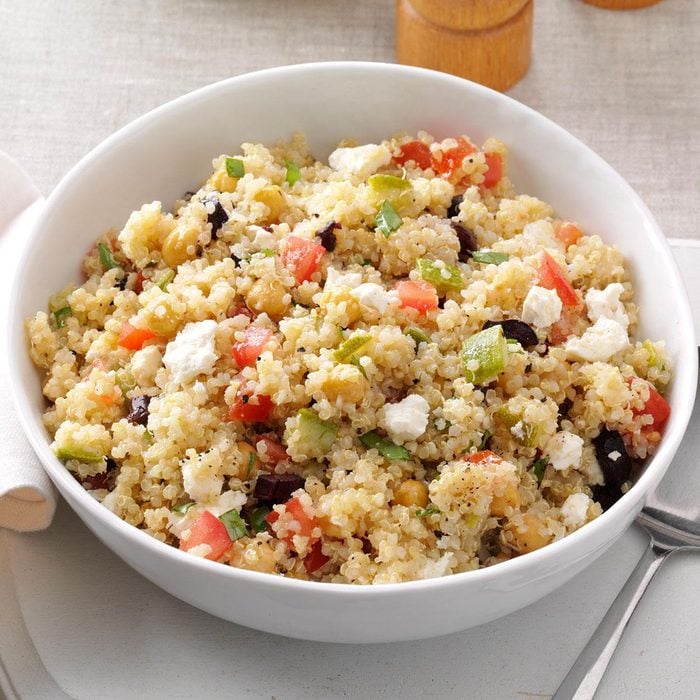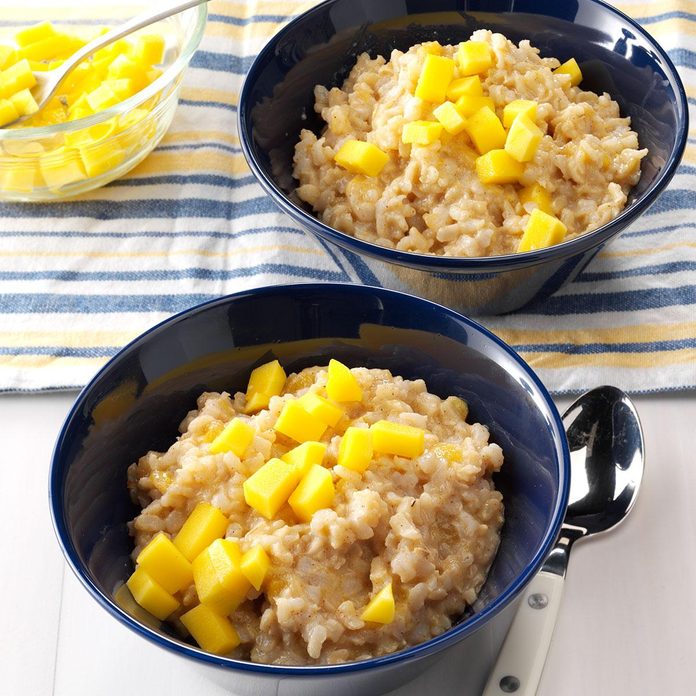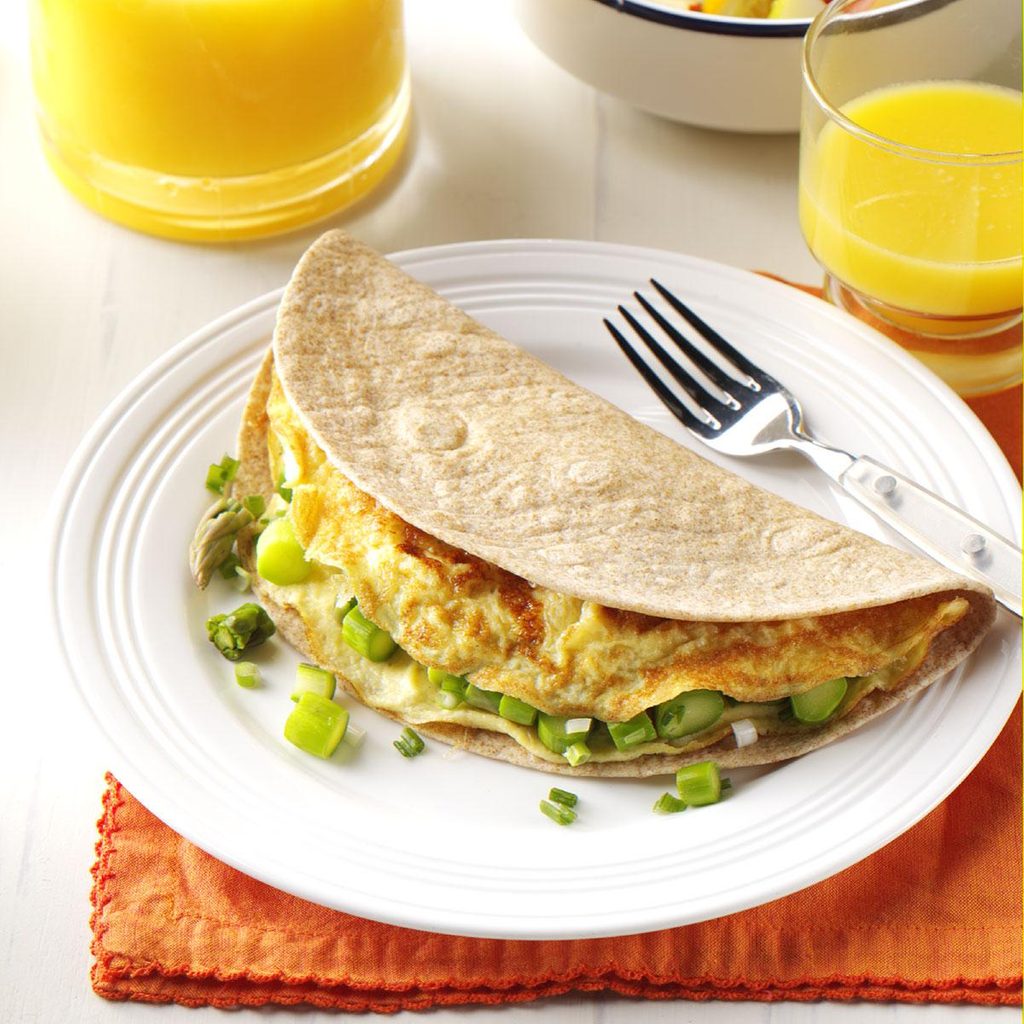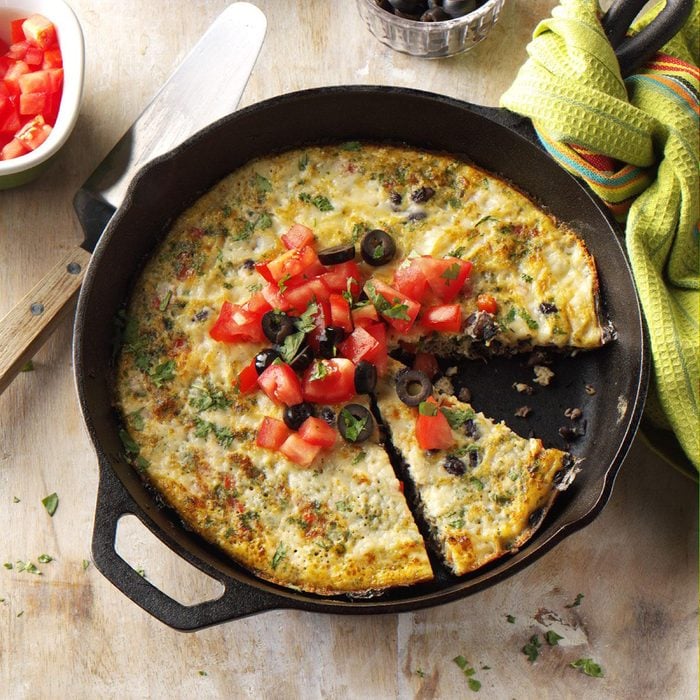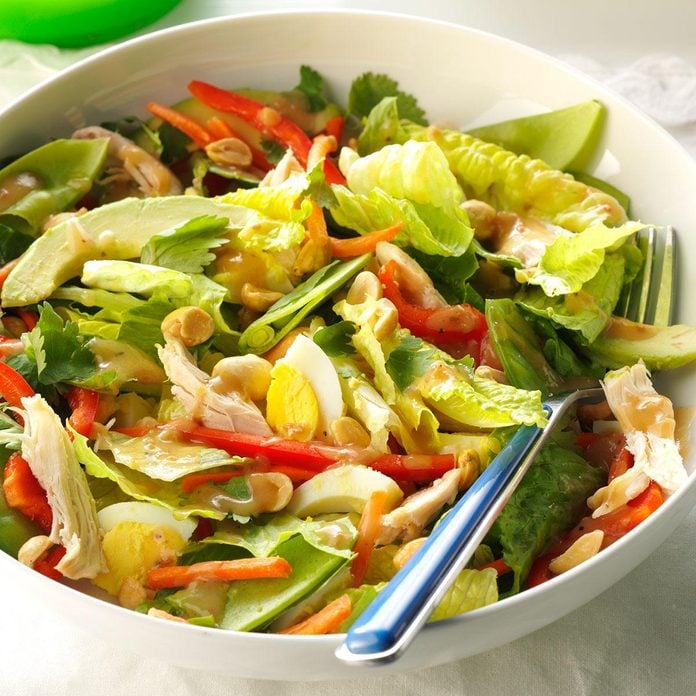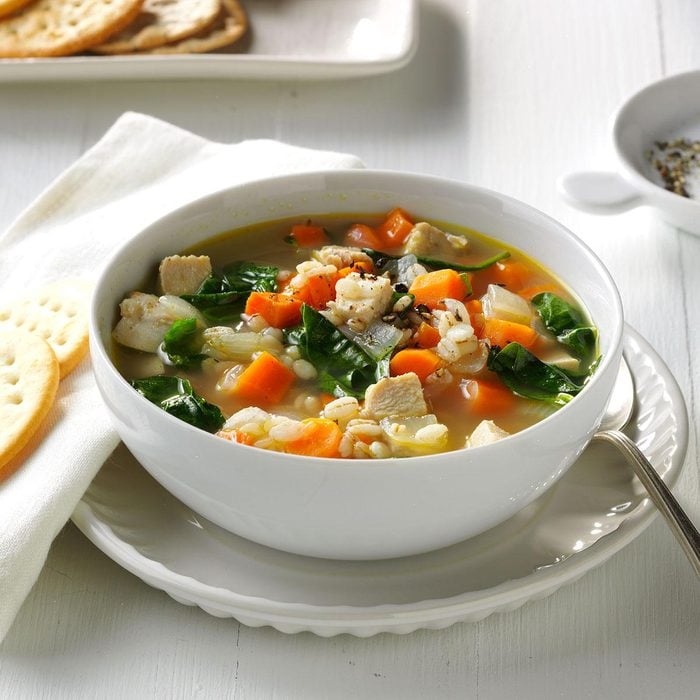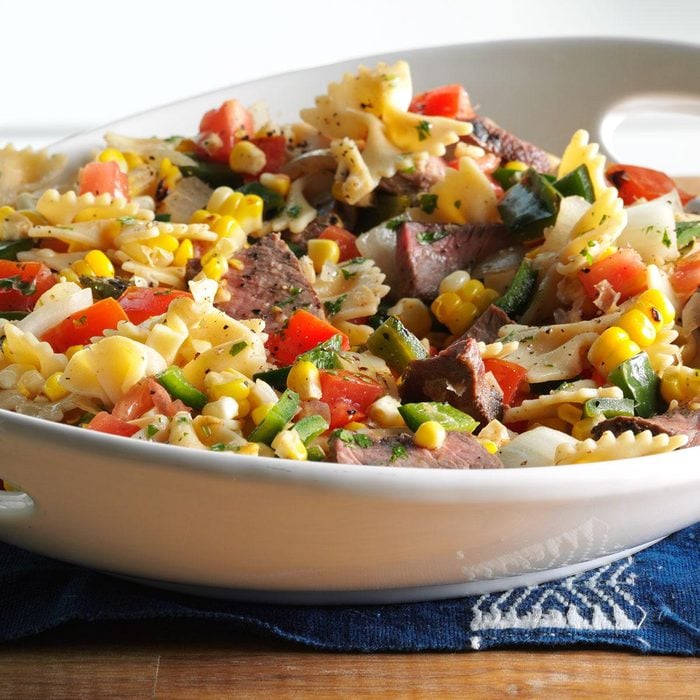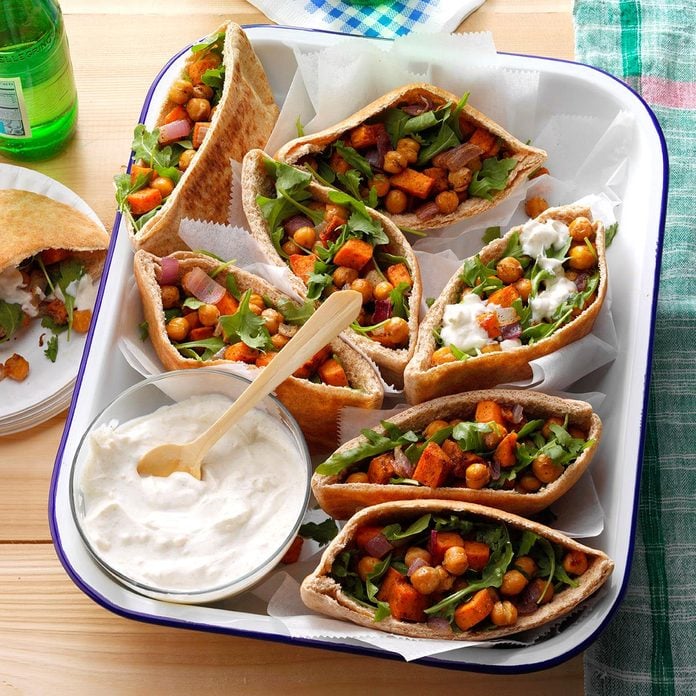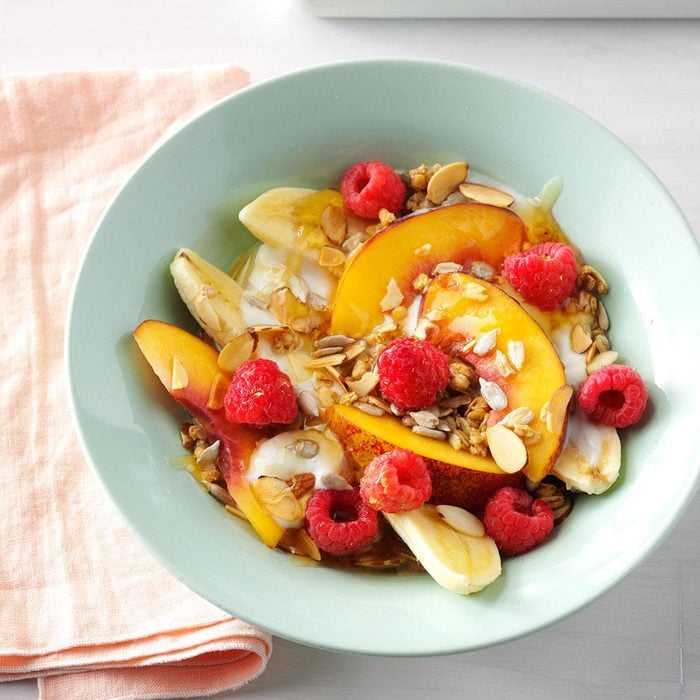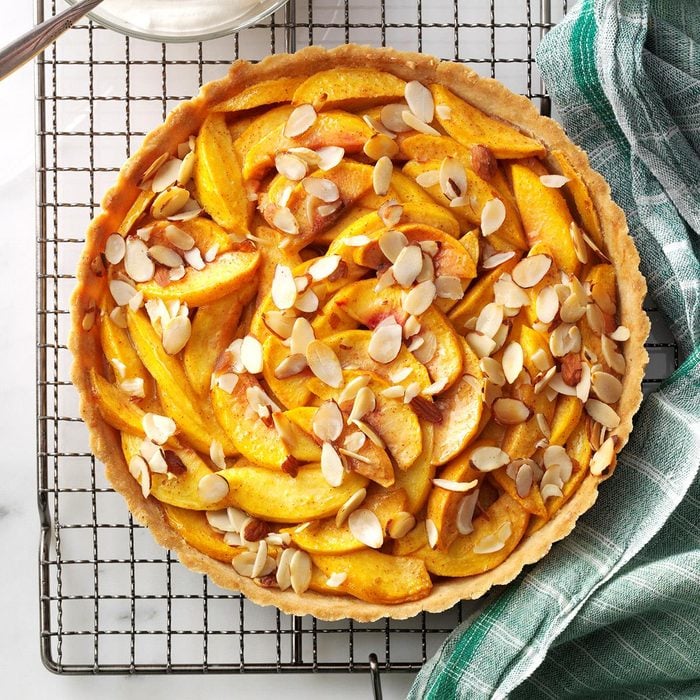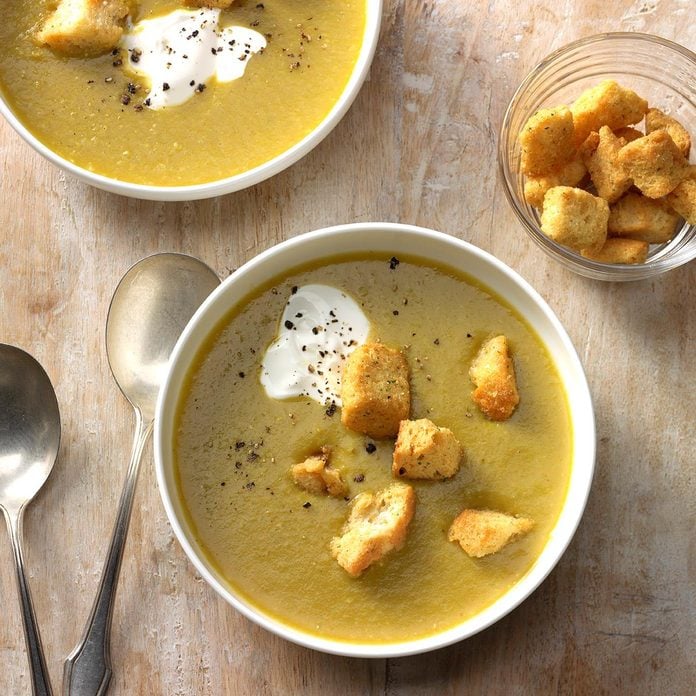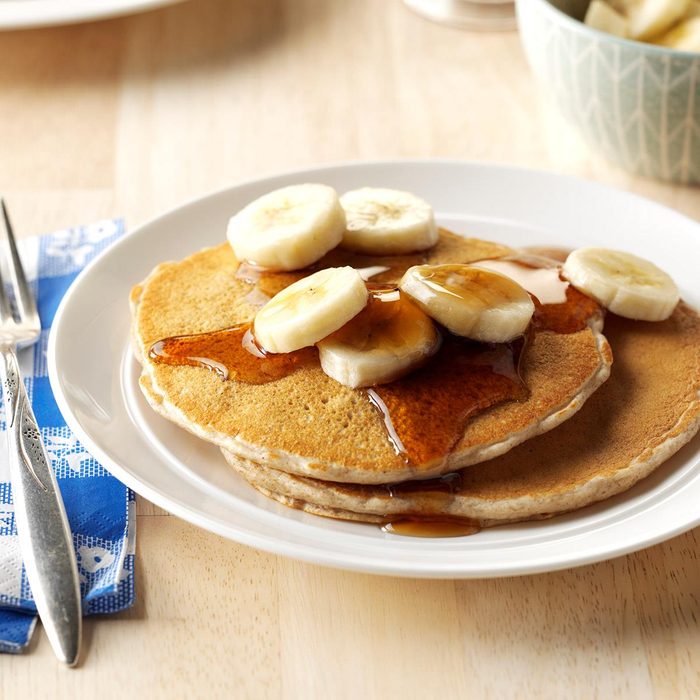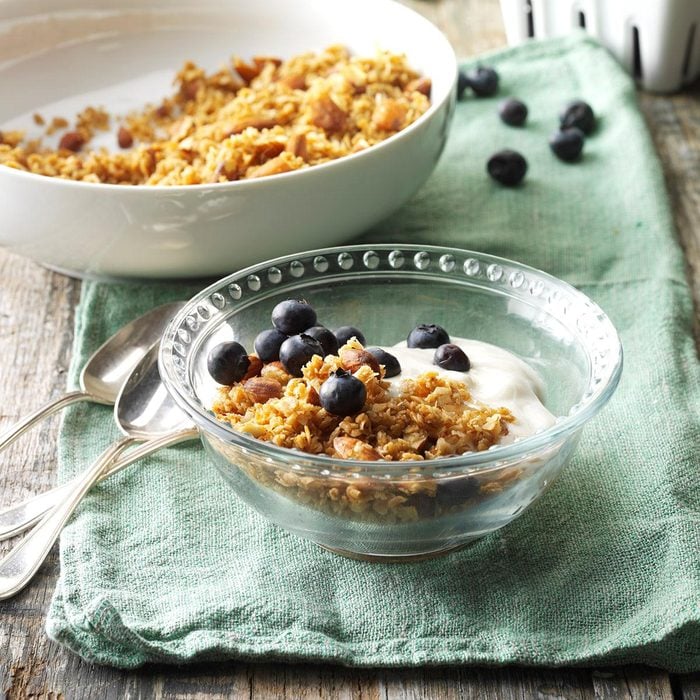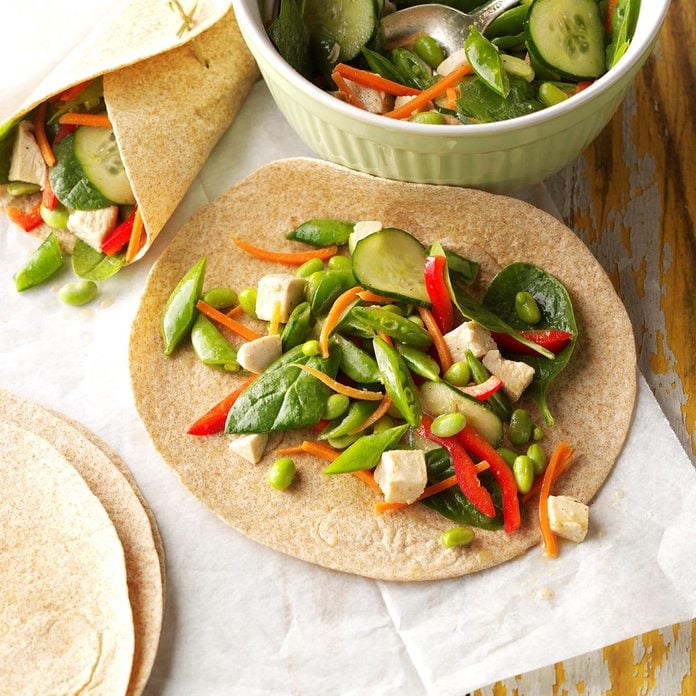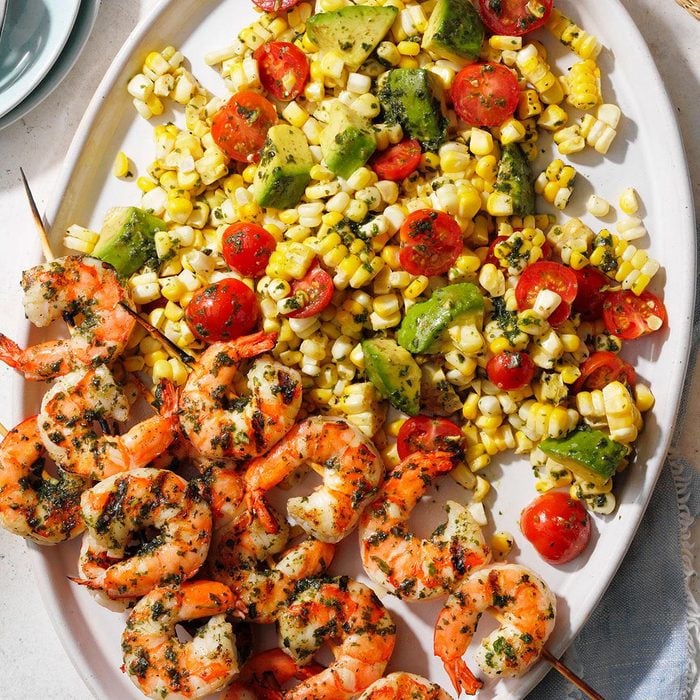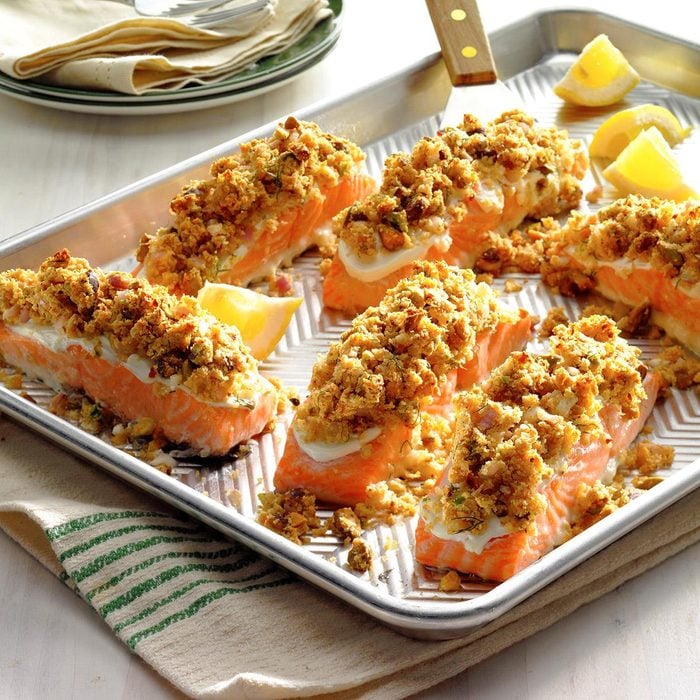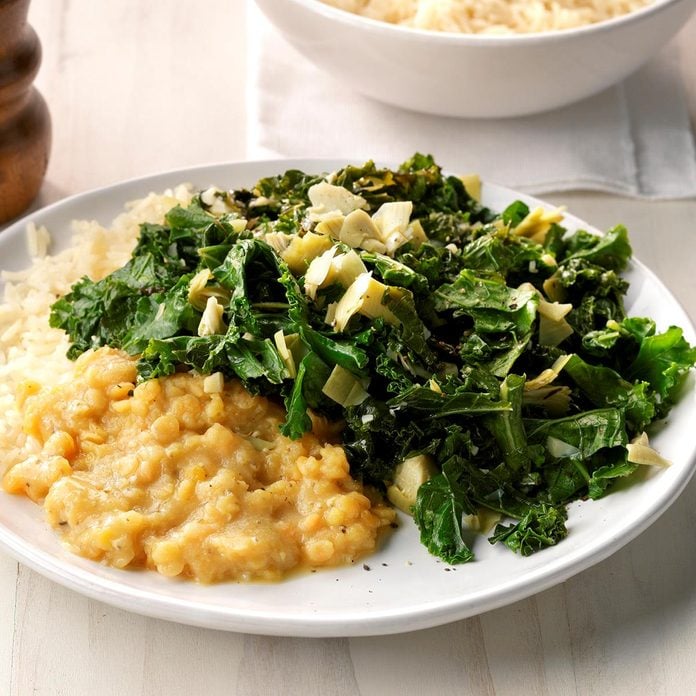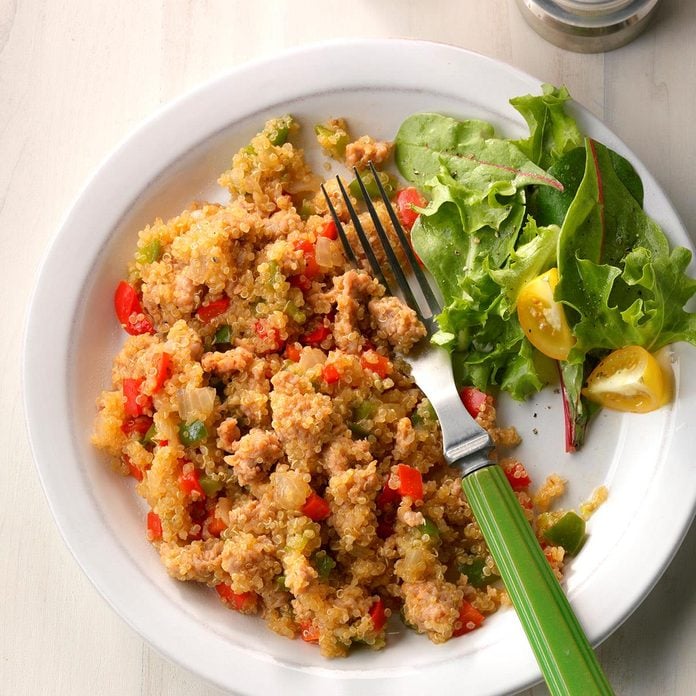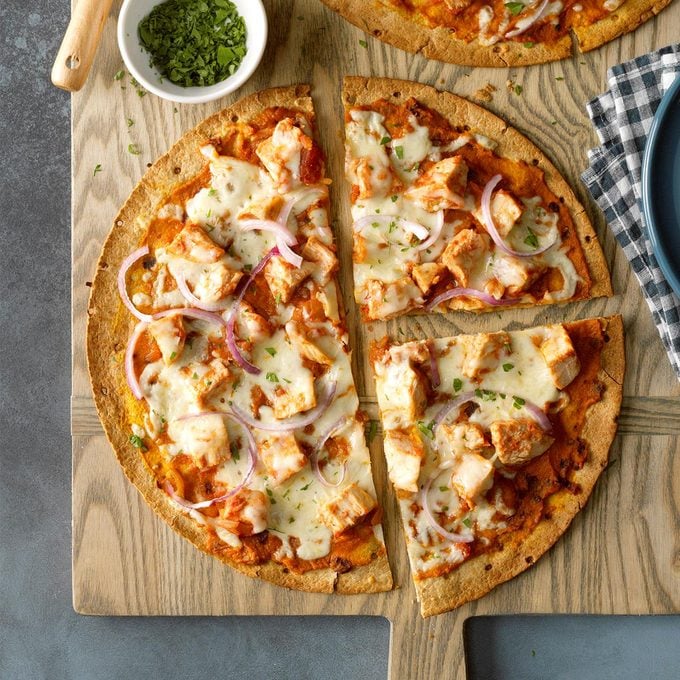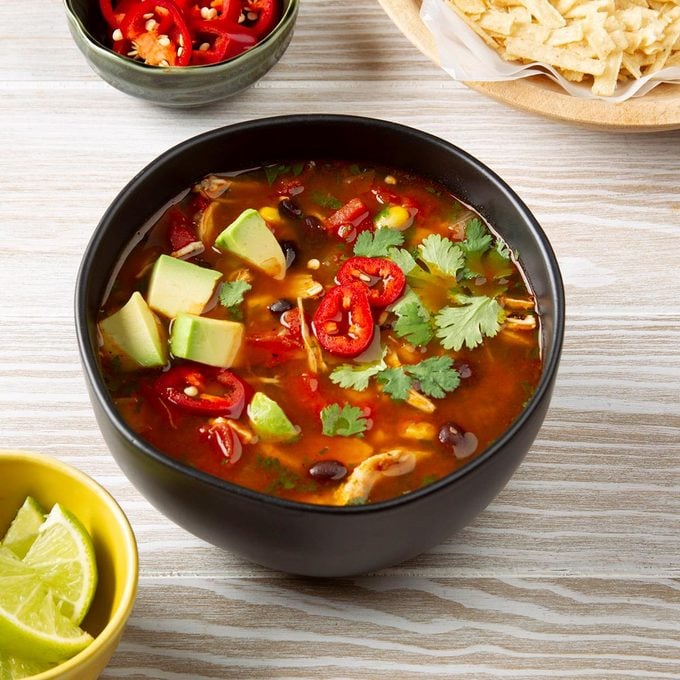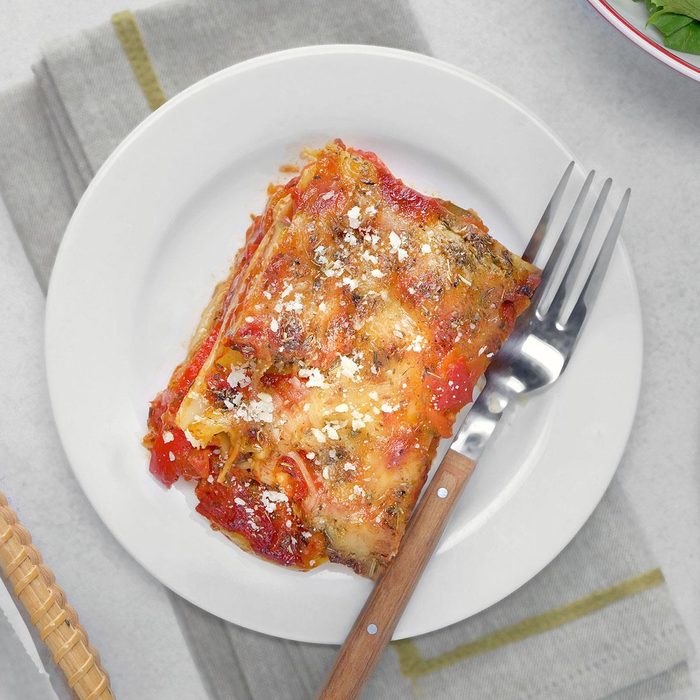Eat smart with these healthy dinners.
Italian Hot Dish
Nutrition Facts
1 serving: 394 calories, 15g fat (6g saturated fat), 82mg cholesterol, 704mg sodium, 32g carbohydrate (5g sugars, 5g fiber), 34g protein. Diabetic Exchanges: 3 lean meat, 2 starch, 2 vegetable, 1/2 fat.
My husband had a poor perception of healthy food until he tried this beefy casserole. The combination of pasta, oregano, mushrooms and green peppers makes it one of our favorite
healthy winter dinner recipes. —Theresa Smith, Sheboygan, Wisconsin
Go to Recipe
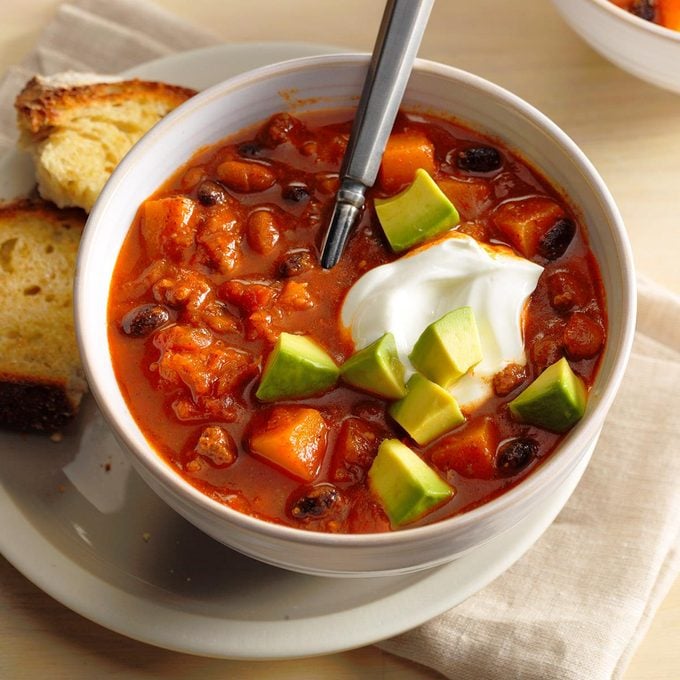 Taste of Home
Taste of Home
1 cup: 261 calories, 8g fat (3g saturated fat), 35mg cholesterol, 704mg sodium, 32g carbohydrate (6g sugars, 8g fiber), 18g protein.
I love how a hint of heat with a touch of sweetness from the Gustus Vitae spicy chocolate cinnamon cane sugar adds another layer of flavor to this contest-winning chili recipe from Jeanne Larson of Rancho Santa Margarita, California. —Peggy Woodward, Taste of Home Food Editor
Go to Recipe
 Taste of Home
Taste of Home
3/4 cup: 367 calories, 9g fat (2g saturated fat), 5mg cholesterol, 327mg sodium, 60g carbohydrate (23g sugars, 9g fiber), 14g protein.
This recipe is simple and beautiful. It uses a lot of unique flavors that, when blended together, create an out-of-this-world taste sensation. You can substitute other roasted, salted nuts for the soy nuts and can use warmed berry jam in place of the molasses. —Mary Baker, Wauwatosa, Wisconsin
Go to Recipe
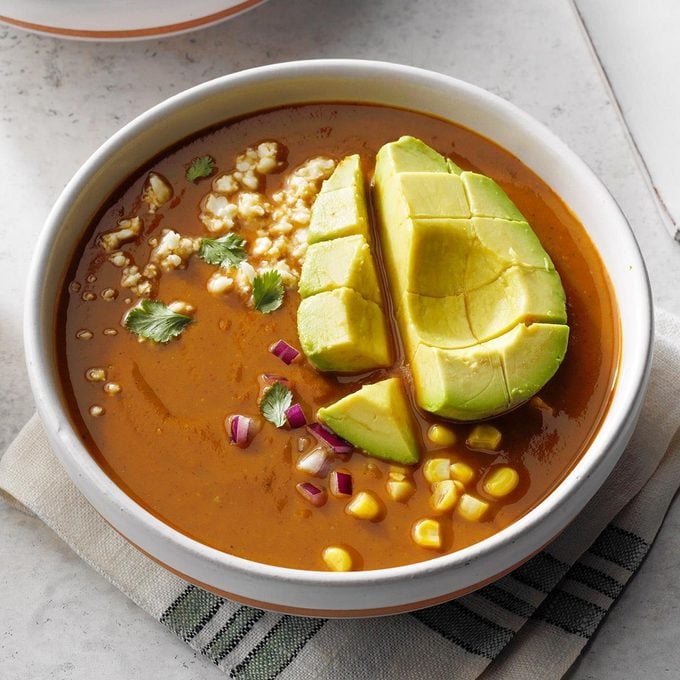 Taste of Home
Taste of Home
1-1/4 cups: 203 calories, 6g fat (2g saturated fat), 0 cholesterol, 511mg sodium, 31g carbohydrate (14g sugars, 5g fiber), 4g protein. Diabetic Exchanges: 2 starch, 1 fat.
This recipe is perfect for those days when you’re craving something just a little bit different. It’s spicy, flavorful and a great excuse to open up a bar of chocolate (if you’re the type of person who needs an excuse!). Even with chocolate, though, this is still a healthy winter dinner recipe. —Colleen Delawder, Herndon, Virginia
Go to Recipe
Spicy Chicken Pumpkin Pizza
Nutrition Facts
1 slice: 225 calories, 9g fat (3g saturated fat), 37mg cholesterol, 504mg sodium, 21g carbohydrate (4g sugars, 3g fiber), 15g protein. Diabetic Exchanges: 2 lean meat, 1 starch, 1 vegetable, 0.500 fat.
Think pizza and pumpkin can’t go together? This chicken pumpkin pizza will change your mind. The sweetness of the pumpkin paired with the spice of the chipotle peppers makes for a delicious, balanced sauce. I love that this recipe incorporates healthy ingredients in a fun, family-friendly way. —Julie Peterson, Crofton, Maryland
Go to Recipe
 Taste of Home
Taste of Home
1-1/3 cups: 318 calories, 14g fat (3g saturated fat), 76mg cholesterol, 628mg sodium, 24g carbohydrate (8g sugars, 5g fiber), 26g protein. Diabetic Exchanges: 3 lean meat, 2 fat, 1-1/2 starch.
I'm still settling into married life and learning how to balance our busy schedules. This quick one-dish ground turkey sweet potato skillet helps keep us on track throughout the week. —Shannon Barden, Alpharetta, Georgia
Go to Recipe
Kimchi Cauliflower Fried Rice
Nutrition Facts
1 serving: 254 calories, 17g fat (5g saturated fat), 204mg cholesterol, 715mg sodium, 13g carbohydrate (6g sugars, 6g fiber), 15g protein. Diabetic Exchanges: 2 high-fat meat, 2 vegetable.
This healthier take on kimchi fried rice is one of my favorite recipes because it's customizable. If there's a vegetarian in the family, leave out the bacon and add your favorite veggies. —Stefanie Schaldenbrand, Los Angeles, California
Go to Recipe
Pressure-Cooker Chicken Tortilla Soup
Nutrition Facts
1 cup: 141 calories, 3g fat (0 saturated fat), 25mg cholesterol, 580mg sodium, 15g carbohydrate (3g sugars, 3g fiber), 14g protein. Diabetic Exchanges: 2 lean meat, 1 starch.
Don't be shy about loading up the spices and shredded chicken into your pressure cooker. Chicken tortilla soup tastes great as leftovers the next day. Your family will thank you for this one! —Karen Kelly, Germantown, Maryland
Go to Recipe
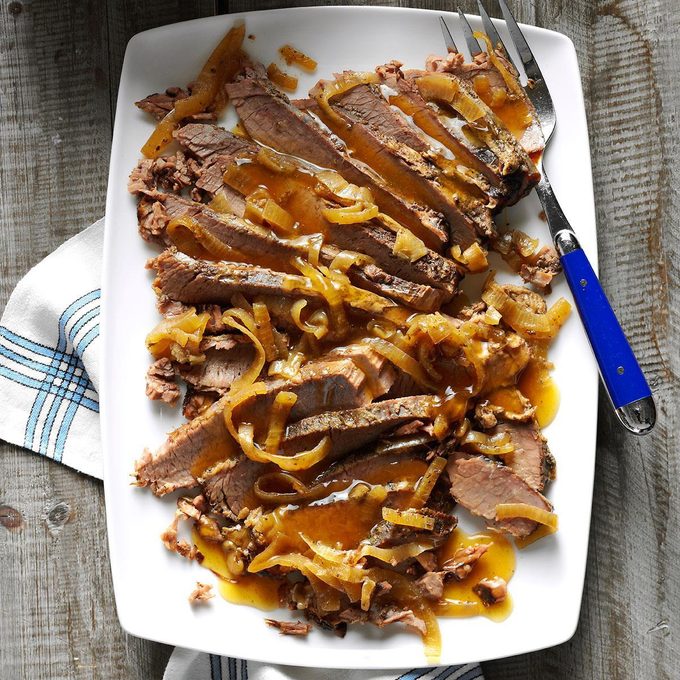 Taste of Home
Taste of Home
1 serving: 285 calories, 8g fat (3g saturated fat), 80mg cholesterol, 430mg sodium, 7g carbohydrate (3g sugars, 0 fiber), 39g protein.
One bite of this super tender brisket and your family will be hooked! The rich gravy is perfect for spooning over a side of creamy mashed potatoes. —Eunice Stoen, Decorah, Iowa
Go to Recipe
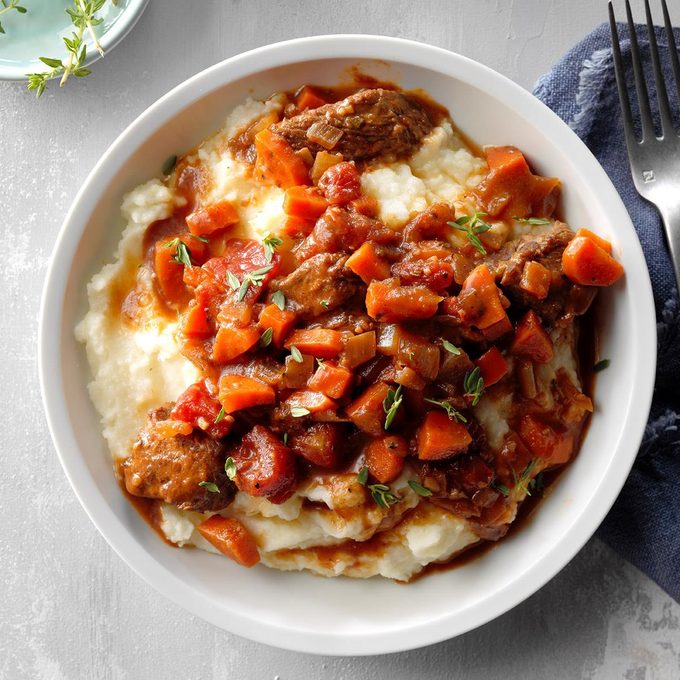 Taste of Home
Taste of Home
1 cup beef mixture: 248 calories, 12g fat (4g saturated fat), 74mg cholesterol, 652mg sodium, 10g carbohydrate (5g sugars, 2g fiber), 24g protein. Diabetic Exchanges: 3 lean meat, 1 vegetable.
My dish is perfect on chilly nights, especially after we have been out chopping wood. The melt-in-your-mouth goodness makes it a staple in my menu rotation of healthy winter dinner recipes. —Brenda Ryan, Marshall, Missouri
Go to Recipe
 Taste of Home
Taste of Home
1 pork chop with 1-1/4 cups vegetables: 516 calories, 17g fat (4g saturated fat), 82mg cholesterol, 505mg sodium, 51g carbohydrate (19g sugars, 9g fiber), 39g protein. Diabetic exchanges: 5 lean meat, 3 starch, 1-1/2 fat, 1 vegetable.
Most nights I need something that I can get on the table with minimal effort and delicious results. This sheet-pan supper has become an all-time favorite, not only because of its bright flavors but also because of its speedy cleanup time! —Elisabeth Larsen, Pleasant Grove, Utah
Go to Recipe
 Taste of Home
Taste of Home
1 serving: 278 calories, 11g fat (5g saturated fat), 72mg cholesterol, 611mg sodium, 10g carbohydrate (5g sugars, 2g fiber), 32g protein. Diabetic Exchanges: 4 lean meat, 1 vegetable.
I traveled to Cuba a few years ago and had some of the best food imaginable. This dish stuck out, and when I returned home, I began to experiment with making ropa vieja in the slow cooker. I hope you enjoy the flavors of Cuba as much as I do. —Joshua Boyer, Traverse City, Michigan
Go to Recipe
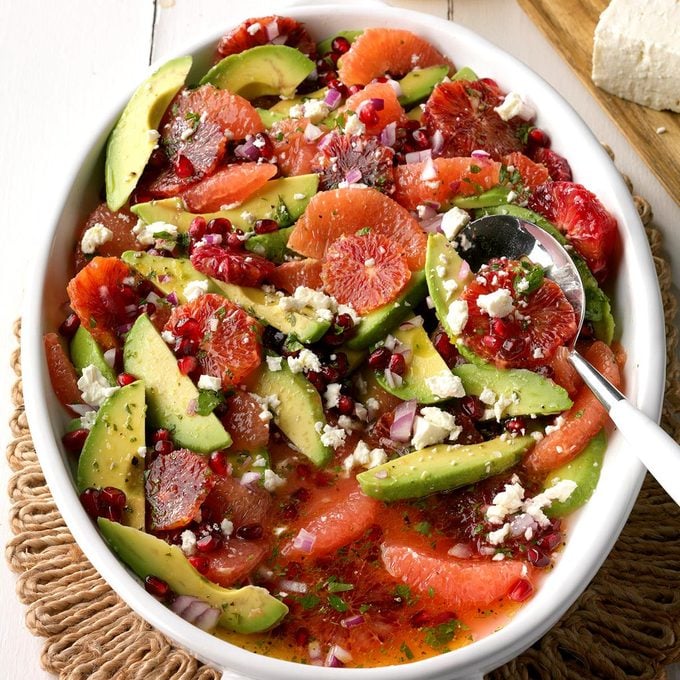 Taste of Home
Taste of Home
1 serving: 241 calories, 16g fat (3g saturated fat), 2mg cholesterol, 89mg sodium, 24g carbohydrate (17g sugars, 6g fiber), 3g protein. Diabetic Exchanges: 3 fat, 1 fruit, 1/2 starch.
My refreshing side salad is such a nice addition to our calorie-loaded Thanksgiving dinner. Use regular oranges if you can't find blood oranges. Finely chopped walnuts work well in place of the pomegranate seeds, too. —Nancy Heishman, Las Vegas, Nevada
Go to Recipe
 Taste of Home
Taste of Home
3/4 cup: 235 calories, 9g fat (2g saturated fat), 7mg cholesterol, 139mg sodium, 31g carbohydrate (6g sugars, 5g fiber), 7g protein. Diabetic Exchanges: 2 starch, 2 fat, 1 vegetable.
This filling vegetarian recipe is a tasty mashup of chicken Marsala and mushroom barley soup. It's great as a main dish, but it can also be served, with or without the barley, as a side. —Arlene Erlbach, Morton Grove, Illinois
Go to Recipe
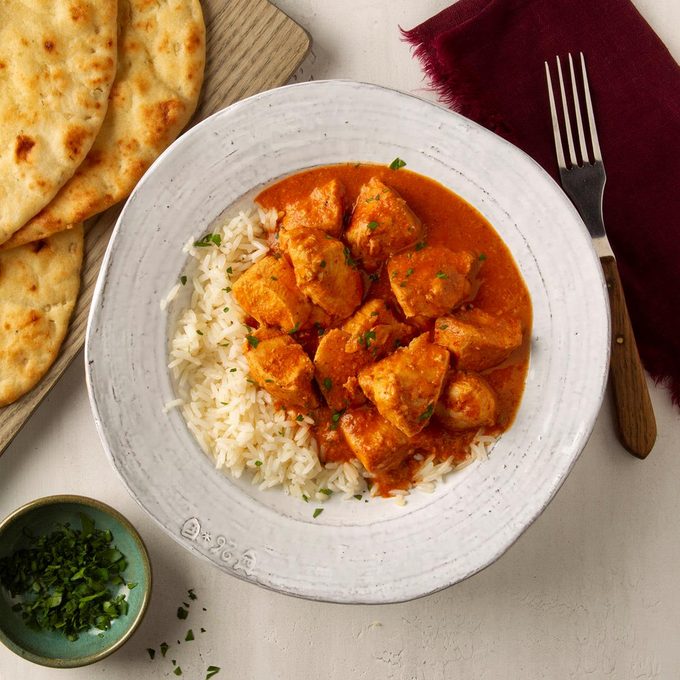 Taste of Home
Taste of Home
1 cup: 242 calories, 9g fat (3g saturated fat), 102mg cholesterol, 407mg sodium, 4g carbohydrate (1g sugars, 1g fiber), 35g protein. Diabetic Exchanges: 5 lean meat, 1 fat.
This slow-cooker butter chicken recipe is similar to the Middle Eastern version I had in Malaysia. I spent several years there eating a variety of Middle Eastern and Southeast Asian food. Butter chicken was one of my favorite dishes while I was there! —Shannon Copley, Upper Arlington, Ohio
Go to Recipe
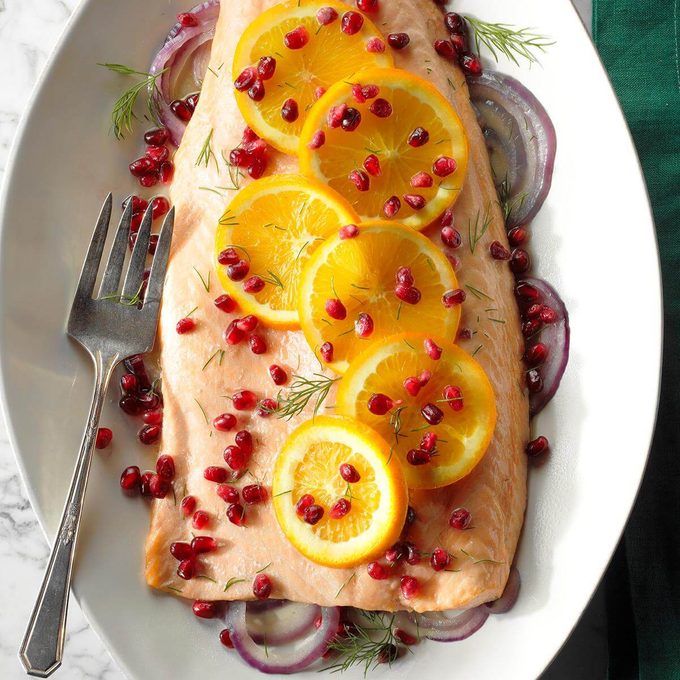 Taste of Home
Taste of Home
4 ounces cooked salmon: 307 calories, 19g fat (3g saturated fat), 76mg cholesterol, 274mg sodium, 8g carbohydrate (6g sugars, 1g fiber), 26g protein. Diabetic Exchanges: 4 lean meat, 1-1/2 fat, 1/2 fruit.
A colorful, festive salmon dish makes an impressive addition to your holiday table—and it is as delicious as it is beautiful. What will no one guess? How easy it is to cook. I serve this with roasted baby potatoes and asparagus for a showstopping meal that is wonderful for special occasions. —Thomas Faglon, Somerset, New Jersey
Go to Recipe
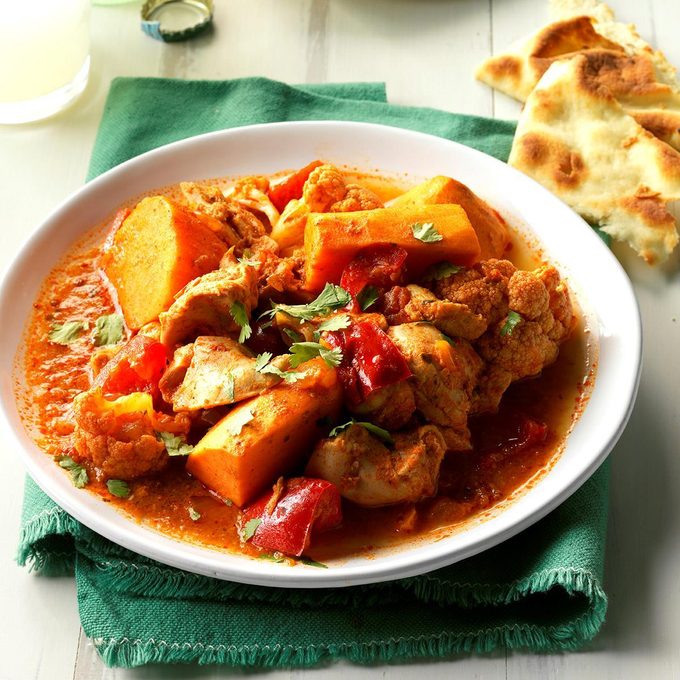 Taste of Home
Taste of Home
1-1/4 cups: 334 calories, 15g fat (4g saturated fat), 80mg cholesterol, 686mg sodium, 25g carbohydrate (12g sugars, 5g fiber), 25g protein. Diabetic Exchanges: 3 lean meat, 2 fat, 1-1/2 starch.
This easy Indian-influenced dish is one just about everyone will love. Feel free to add more or less tikka masala sauce according to your taste. —Erica Polly, Sun Prairie, Wisconsin
Go to Recipe
 Taste of Home
Taste of Home
3 slices: 201 calories, 8g fat (2g saturated fat), 71mg cholesterol, 492mg sodium, 5g carbohydrate (2g sugars, 2g fiber), 26g protein. Diabetic Exchanges: 4 lean meat, 1/2 fat.
Spicy stuffing balances the delicate flavor of pork in this dish that looks great on the plate—and tastes even better! —Margaret Allen, Abingdon, Virginia
Go to Recipe
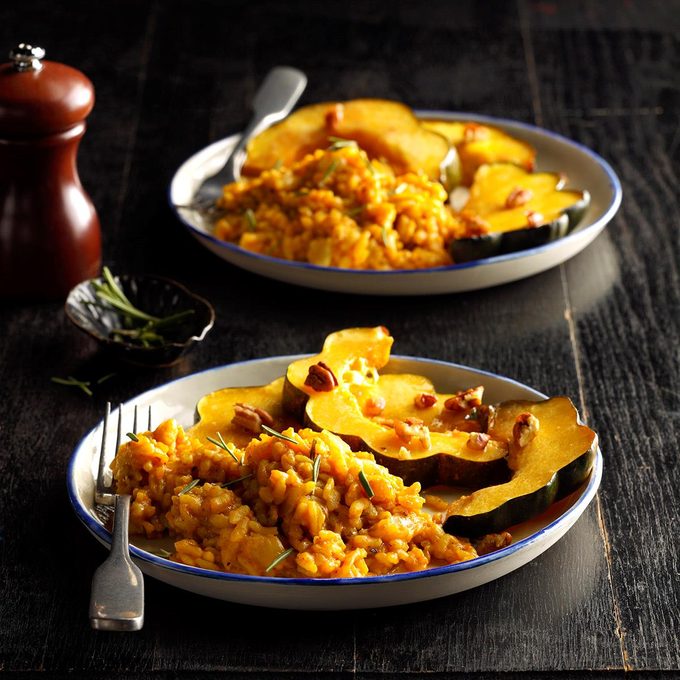 Taste of Home
Taste of HomePressure-Cooker Curried Pumpkin Risotto
Nutrition Facts
1/2 cup: 163 calories, 3g fat (0 saturated fat), 0 cholesterol, 369mg sodium, 30g carbohydrate (2g sugars, 2g fiber), 4g protein. Diabetic exchanges: 2 starch, 1/2 fat.
This easy pumpkin risotto tastes like fall and gets a flavor boost from the curry. —Andrea Reaves, Stephens City, Virginia
Go to Recipe
 Taste of Home
Taste of Home
1 cup: 271 calories, 6g fat (2g saturated fat), 9mg cholesterol, 672mg sodium, 41g carbohydrate (7g sugars, 13g fiber), 18g protein. Diabetic Exchanges: 3 starch, 1 medium-fat meat.
This quick soup feels extra cozy with lots of lentils and a touch of smoky, bacony goodness. You might want to cook up extra—I think it's even better the next day! —Janie Zirbser, Mullica Hill, New Jersey
Go to Recipe
Fiery Stuffed Poblanos
Nutrition Facts
1 stuffed pepper: 223 calories, 5g fat (2g saturated fat), 15mg cholesterol, 579mg sodium, 32g carbohydrate (9g sugars, 7g fiber), 11g protein. Diabetic Exchanges: 2 vegetable, 1 starch, 1 lean meat, 1 fat.
I love southwest-inspired cuisine, but the dishes are often unhealthy. As a dietitian, I try to come up with nutritious twists on recipes, which is how these stuffed peppers were born. —Amber Massey, Coppell, Texas
Go to Recipe
 Taste of Home
Taste of Home
1-1/2 cups: 289 calories, 5g fat (0 saturated fat), 0 cholesterol, 702mg sodium, 48g carbohydrate (5g sugars, 9g fiber), 13g protein.
This vegan tortilla soup recipe is healthy, filling and family-friendly! We love how hearty and flavorful it is. We like to play around with the different toppings we add each time it's served. —Julie Peterson, Crofton, Maryland
Go to Recipe
 Taste of Home
Taste of Home
1 serving: 386 calories, 13g fat (3g saturated fat), 76mg cholesterol, 556mg sodium, 44g carbohydrate (12g sugars, 3g fiber), 25g protein.
I'm always looking to try recipes from different cultures, and this one is a huge favorite. We love the spice combinations. This cooks equally well in a slow cooker or a pressure cooker. —Courtney Stultz, Weir, Kansas
Go to Recipe
 Taste of Home
Taste of Home
1 cup ragu: 195 calories, 8g fat (3g saturated fat), 52mg cholesterol, 426mg sodium, 13g carbohydrate (6g sugars, 2g fiber), 17g protein. Diabetic exchanges: 2 lean meat, 1 starch.
This recipe is a marvelously spicy combo that's perfect for cooler fall weather and satisfying after a day spent outdoors. —Monica Osterhaus, Paducah, Kentucky
Go to Recipe
 Taste of Home
Taste of Home
1 cup: 288 calories, 12g fat (2g saturated fat), 73mg cholesterol, 635mg sodium, 15g carbohydrate (3g sugars, 3g fiber), 29g protein. Diabetic Exchanges: 3 lean meat, 1 starch, 1 fat.
Growing up in a Pennsylvania Dutch area, I was surrounded by excellent cooks and wonderful foods. I enjoy experimenting with new recipes, like this change-of-pace chili. —Kaye Whiteman, Charleston, West Virginia
Go to Recipe
 Taste of Home
Taste of Home
1 serving: 244 calories, 11g fat (3g saturated fat), 78mg cholesterol, 356mg sodium, 9g carbohydrate (4g sugars, 2g fiber), 23g protein. Diabetic exchanges: 3 lean meat, 1 vegetable, 1/2 fat.
Don’t be intimidated by the elegant name. The classic French dish is now made easier in one appliance! This Instant Pot coq au vin has all the classic flavors of a rich red wine-mushroom sauce but is so simple to make. My family loves it with whole grain country bread or French bread for dipping into the extra sauce. —Julie Peterson, Crofton, Maryland
Go to Recipe
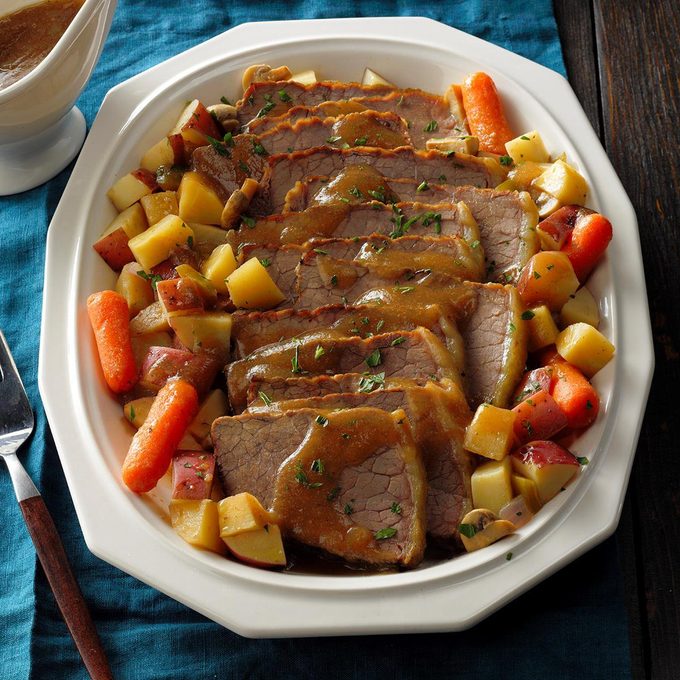 Taste of Home
Taste of Home
1 serving: 304 calories, 8g fat (3g saturated fat), 101mg cholesterol, 533mg sodium, 19g carbohydrate (4g sugars, 3g fiber), 36g protein. Diabetic Exchanges: 5 lean meat, 1 starch.
Because this healthy dish is slow-cooked, you can use less expensive roasts with results as mouthwatering as the more costly cuts. Change up the veggies for variety, nutrition or to suit your tastes!—Sandra Dudley, Bemidji, Minnesota
Go to Recipe
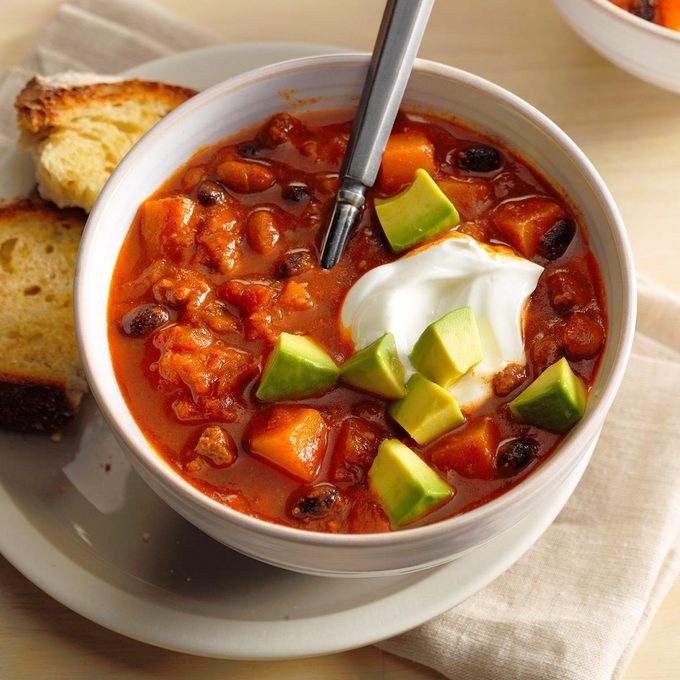 Taste of Home
Taste of Home
1 cup: 261 calories, 8g fat (3g saturated fat), 35mg cholesterol, 704mg sodium, 32g carbohydrate (6g sugars, 8g fiber), 18g protein. Diabetic Exchanges: 2 starch, 2 lean meat.
Add butternut squash to chili for a tasty, filling, energy-packed dish your whole family will love. Mine does! —Jeanne Larson, Mission Viejo, California
Go to Recipe
 Taste of Home
Taste of Home
1 serving: 505 calories, 17g fat (3g saturated fat), 55mg cholesterol, 518mg sodium, 41g carbohydrate (8g sugars, 5g fiber), 42g protein.
For something new to do with tuna, I suggest this tangy dish. Although I prefer the marinade on tuna or mahi mahi, it's scrumptious on any fish, grilled, baked or broiled. —Caren Stearns, Austin, Texas
Go to Recipe
 Taste of Home
Taste of Home
1 serving: 286 calories, 14g fat (5g saturated fat), 89mg cholesterol, 635mg sodium, 9g carbohydrate (4g sugars, 1g fiber), 29g protein. Diabetic Exchanges: 4 lean meat, 1/2 starch, 1/2 fat.
I love stir-fry with black bean sauce. This recipe takes that same delicious flavor and combines it with fork-tender pot roast. —Judy Lawson, Chelsea, Michigan
Go to Recipe
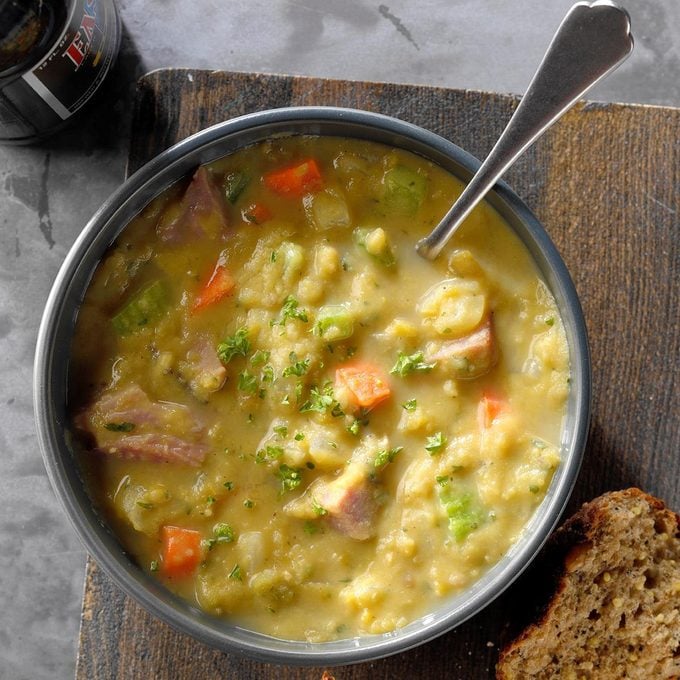 Taste of Home
Taste of Home
1 cup: 141 calories, 1g fat (0 saturated fat), 1mg cholesterol, 193mg sodium, 25g carbohydrate (6g sugars, 9g fiber), 9g protein. Diabetic Exchanges: 1-1/2 starch, 1 lean meat.
This family favorite is the same recipe my grandmother used. Now with the magic of the slow cooker, I can spend 15 minutes putting it together, walk away for five hours, and come back to "soup's on." Finish it with more milk if you like your soup a bit thinner. —Judy Batson, Tampa, Florida
Go to Recipe
 Taste of Home
Taste of Home
1 cup: 302 calories, 7g fat (1g saturated fat), 63mg cholesterol, 237mg sodium, 34g carbohydrate (20g sugars, 5g fiber), 25g protein. Diabetic exchanges: 3 lean meat, 3 vegetable, 1 fruit, 1 fat.
If you'd like a little extra crunch with this colorful chop suey, serve with chow mein noddles. —George Utley, South Hill, Virginia
Go to Recipe
 Taste of Home
Taste of Home
1 each: 257 calories, 7g fat (3g saturated fat), 123mg cholesterol, 564mg sodium, 20g carbohydrate (5g sugars, 1g fiber), 29g protein. Diabetic Exchanges: 4 lean meat, 1-1/2 starch, 1/2 fat.
Stuffed with a succulent combination of wild rice, mushrooms and dried cranberries, these golden hens are sure to become a special-occasion entree in your home. They're a wonderful change of pace from traditional turkey. —Nancy Horsburgh, Everett, Ontario
Go to Recipe
 Taste of Home
Taste of Home
1-1/4 cups: 215 calories, 3g fat (2g saturated fat), 8mg cholesterol, 637mg sodium, 43g carbohydrate (18g sugars, 5g fiber), 5g protein.
I love that I can top this creamy soup with anything my heart desires, which means I can eat it several days in a row without ever having to have it the same way twice. You can substitute fresh onions and celery in this recipe if you prefer, but using the dried version makes it easy to throw together on a weekday morning. —Colleen Delawder, Herndon, Virginia
Go to Recipe
 Taste of Home
Taste of Home
3 ounces cooked beef with 1/2 cup sauce: 172 calories, 5g fat (2g saturated fat), 51mg cholesterol, 592mg sodium, 5g carbohydrate (2g sugars, 1g fiber), 23g protein. Diabetic Exchanges: 3 lean meat.
I adapted this from a slow-cooker recipe to one that takes about 2 hours start to finish, using a pressure cooker. Served over egg noodles or rice, it reminds me of Grandma's house. —Helen Nelander, Boulder Creek, California
Go to Recipe
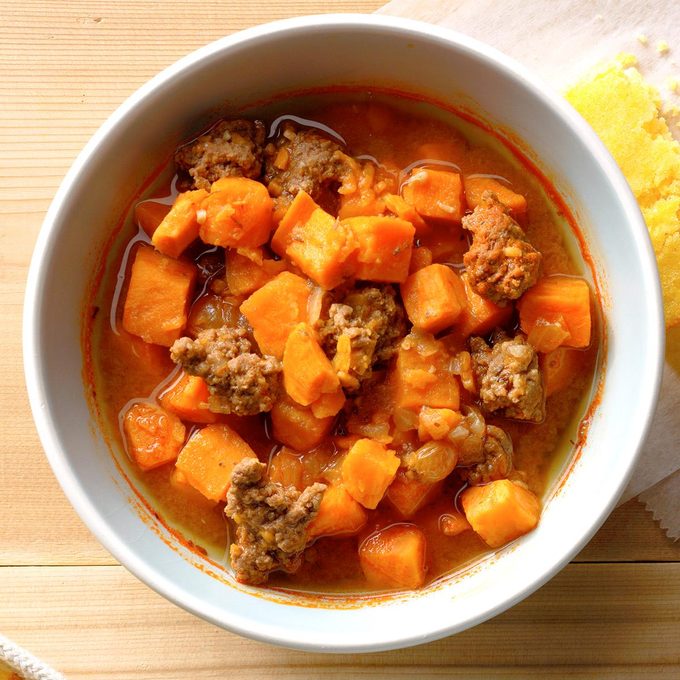 Taste of Home
Taste of Home
1-1/4 cups: 265 calories, 7g fat (3g saturated fat), 58mg cholesterol, 532mg sodium, 29g carbohydrate (13g sugars, 4g fiber), 20g protein. Diabetic Exchanges: 2 starch, 2 lean meat.
Beef broth and herbs complement the sweet potatoes' subtle sweetness in this hearty stew that's perfect for fall. — Helen Vail, Glenside, Pennsylvania
Go to Recipe
 Taste of Home
Taste of Home
1 serving: 132 calories, 3g fat (1g saturated fat), 64mg cholesterol, 420mg sodium, 2g carbohydrate (1g sugars, 1g fiber), 23g protein. Diabetic Exchanges: 3 lean meat.
This tender chicken with a light lime flavor is a natural as a filling for tacos, but my son Austin also loves it spooned over cooked rice and sprinkled with his favorite taco toppings. —Christine Hair, Odessa, Florida
Go to Recipe
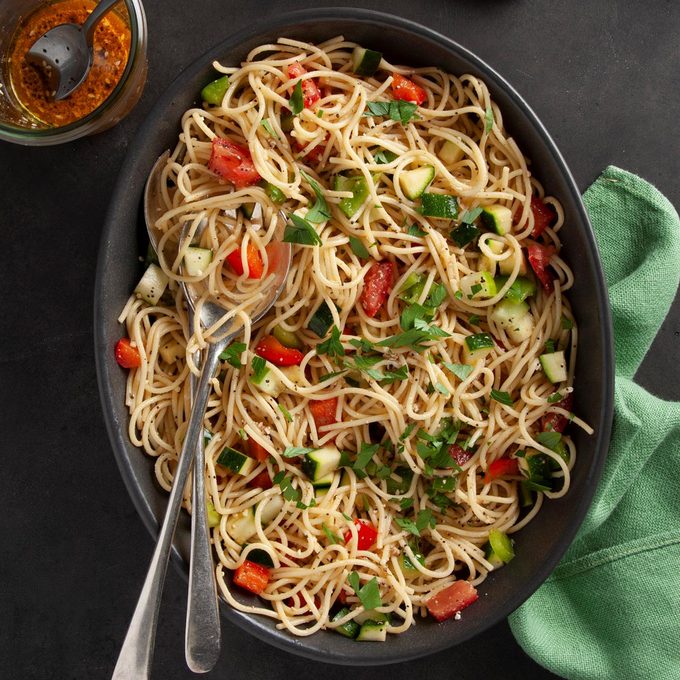 Taste of Home
Taste of Home
1 cup: 158 calories, 3g fat (1g saturated fat), 1mg cholesterol, 168mg sodium, 26g carbohydrate (4g sugars, 2g fiber), 5g protein. Diabetic Exchanges: 1-1/2 starch, 1 vegetable, 1/2 fat.
This attractive, fresh-tasting salad can conveniently be made the night before. It makes enough for a crowd! —Lucia Johnson, Massena, New York
Go to Recipe
 Taste of Home
Taste of Home
1-1/2 cups: 197 calories, 1g fat (0 saturated fat), 0 cholesterol, 678mg sodium, 39g carbohydrate (7g sugars, 9g fiber), 11g protein. Diabetic Exchanges: 2-1/2 starch, 1 lean meat.
My neighbor had an abundance of cabbage, so a group of us had a contest to see who could come up with the best cabbage dish. My vegetarian cabbage soup was the clear winner—they ate the whole pot! —Lorraine Caland, Shuniah, Ontario
Go to Recipe
 Taste of Home
Taste of Home
1 cup: 354 calories, 12g fat (4g saturated fat), 71mg cholesterol, 657mg sodium, 32g carbohydrate (10g sugars, 8g fiber), 31g protein. Diabetic Exchanges: 3 lean meat, 2 starch.
As one of the cooks at the firehouse, I used to prepare meals for 10 men. This chili recipe was among their favorites. —Richard Clements, San Dimas, California
Go to Recipe
 Taste of Home
Taste of Home
1-1/2 cups: 418 calories, 12g fat (2g saturated fat), 165mg cholesterol, 611mg sodium, 40g carbohydrate (10g sugars, 4g fiber), 36g protein. Diabetic Exchanges: 5 lean meat, 2-1/2 starch, 1 fat.
This dish will remind you a bit of classic shrimp Creole, but it has a surprise Italian twist. Pressure cooking gives it hands-off ease—perfect for company. —Karen Edwards, Sanford, Maine
Go to Recipe
 Taste of Home
Taste of Home
1-1/2 cups: 243 calories, 6g fat (1g saturated fat), 52mg cholesterol, 606mg sodium, 27g carbohydrate (5g sugars, 7g fiber), 20g protein. Diabetic exchanges: 2 starch, 2 lean meat.
My slow-cooker chili is packed with flavor. Swapping ground turkey for ground beef lightens it up, and sweet potato puree sneaks in a healthy dose of vitamin A. —Rachel Lewis, Danville, Virginia
Go to Recipe
 Taste of Home
Taste of Home
3/4 cup: 167 calories, 8g fat (2g saturated fat), 27mg cholesterol, 398mg sodium, 16g carbohydrate (6g sugars, 3g fiber), 9g protein. Diabetic exchanges: 2 vegetable, 1 lean meat, 1 fat.
I love to mix different vegetables together and use unexpected herbs and spices to change things up. If you can't find apple sausage for this skillet, a good mild Italian sausage would work just fine. —Patricia Levenson, Santa Ana, California
Go to Recipe
 Taste of Home
Taste of HomeThai Chicken Lettuce Cups
Nutrition Facts
1 lettuce cup: 93 calories, 1g fat (0 saturated fat), 21mg cholesterol, 162mg sodium, 11g carbohydrate (2g sugars, 1g fiber), 9g protein.
Lettuce wraps make light, lively appetizers. These are easy to make because the slow cooker does most of the work. Just load it up and let things get cooking. When the chicken is cooked, just shred and serve. —Robin Haas, West Roxbury, Massachusetts
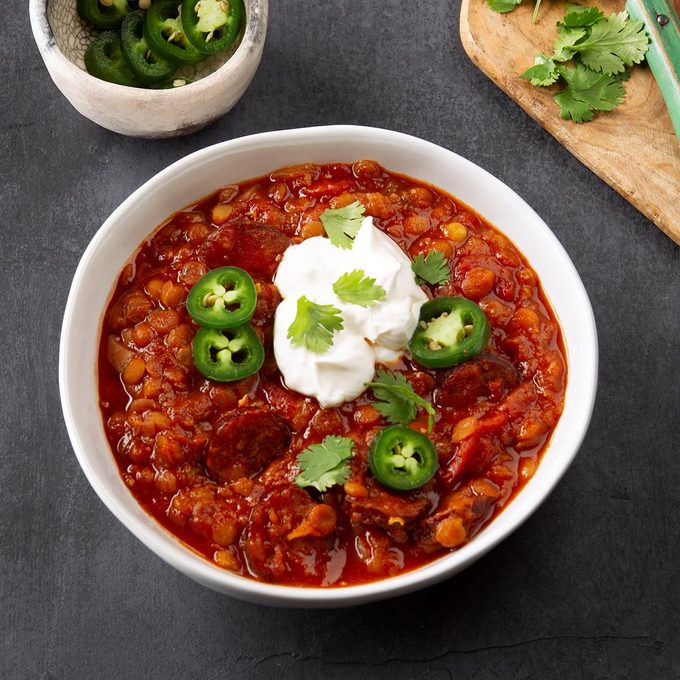 Taste of Home
Taste of Home
1 cup: 267 calories, 8g fat (2g saturated fat), 44mg cholesterol, 849mg sodium, 38g carbohydrate (11g sugars, 6g fiber), 17g protein.
This recipe has been in my family for a number of years and it's still a hit today. The smoky flavor of the andouille sausage adds a lot to humble lentils. And you can make it in either a pressure cooker or a slow cooker. —Melody Gow, Mead, Washington
Go to Recipe
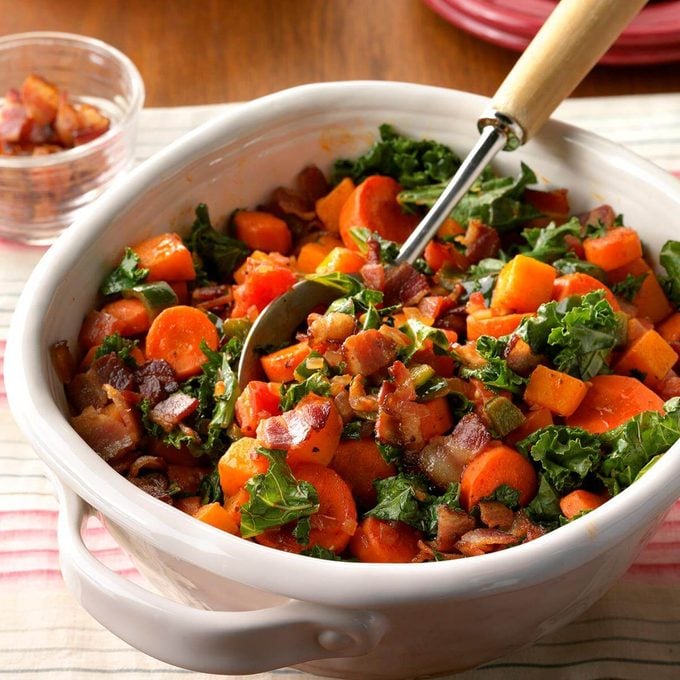 Taste of Home
Taste of Home
3/4 cup: 101 calories, 5g fat (2g saturated fat), 10mg cholesterol, 251mg sodium, 11g carbohydrate (4g sugars, 3g fiber), 4g protein. Diabetic Exchanges: 1 vegetable, 1 fat, 1/2 starch.
Thanks to fresh veggie dishes like this one, I almost forget I'm wheat- and gluten-free. Bacon adds another layer of flavor and depth to this gorgeous side dish. —Darla Andrews, Schertz, Texas
Go to Recipe
Vegetable LasagnaNutrition Facts
1 piece: 432 calories, 19g fat (7g saturated fat), 68mg cholesterol, 857mg sodium, 48g carbohydrate (22g sugars, 7g fiber), 20g protein.
I cooked up this fresh lasagna for vegetarian customers at a local grocery store, where I work part-time. It's absolutely packed with veggies. —Sam Hunsaker, Lawrence, Kansas
 Taste of Home
Taste of Home
1-1/3 cups: 217 calories, 1g fat (0 saturated fat), 0 cholesterol, 685mg sodium, 45g carbohydrate (11g sugars, 8g fiber), 11g protein.
Here’s a healthy slow-cooker soup that's ideal for vegetarians and those watching their weight. Butternut squash and lentils make it hearty, while herbs and other veggies round out the flavor. —Mark Morgan, Waterford, Wisconsin
Go to Recipe
